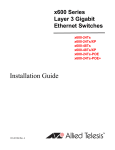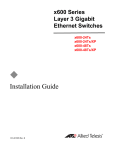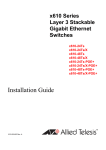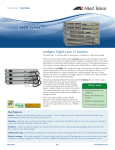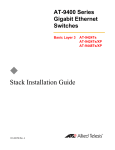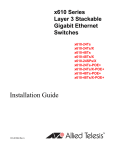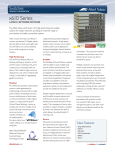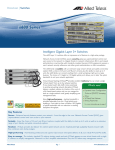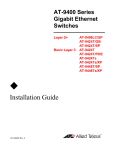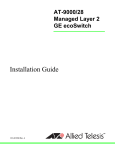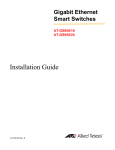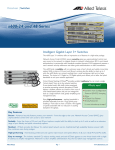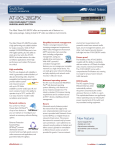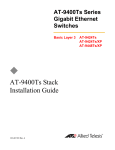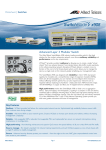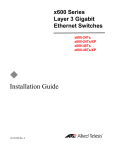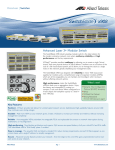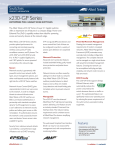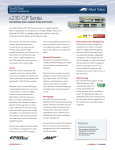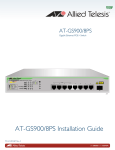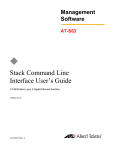Download Allied Telesis x600-24Ts-POE User's Manual
Transcript
x600 Series Layer 3 Gigabit Ethernet Switches x600-24Ts x600-24Ts/XP x600-48Ts x600-48Ts/XP x600-24Ts-POE Installation Guide 613-001248 Rev. A Copyright © 2009 Allied Telesis, Inc. All rights reserved. No part of this publication may be reproduced without prior written permission from Allied Telesis, Inc. Allied Telesis, Alliedware Plus and the Allied Telesis logo are trademarks of Allied Telesis, Incorporated. All other product names, company names, logos or other designations mentioned herein are trademarks or registered trademarks of their respective owners. Allied Telesis, Inc. reserves the right to make changes in specifications and other information contained in this document without prior written notice. The information provided herein is subject to change without notice. In no event shall Allied Telesis, Inc. be liable for any incidental, special, indirect, or consequential damages whatsoever, including but not limited to lost profits, arising out of or related to this manual or the information contained herein, even if Allied Telesis, Inc. has been advised of, known, or should have known, the possibility of such damages. Electrical Safety and Emissions Standards This product meets the following standards. U.S. Federal Communications Commission Radiated Energy Note: This equipment has been tested and found to comply with the limits for a Class A digital device pursuant to Part 15 of FCC Rules. These limits are designed to provide reasonable protection against harmful interference when the equipment is operated in a commercial environment. This equipment generates, uses, and can radiate radio frequency energy and, if not installed and used in accordance with this instruction manual, may cause harmful interference to radio communications. Operation of this equipment in a residential area is likely to cause harmful interference in which case the user will be required to correct the interference at his own expense. Note: Modifications or changes not expressly approved of by the manufacturer or the FCC, can void your right to operate this equipment. Industry Canada This Class A digital apparatus complies with Canadian ICES-003. Cet appareil numérique de la classe A est conforme à la norme NMB-003 du Canada. RFI Emissions FCC Class A, EN55022 Class A, EN61000-3-2, EN61000-3-3, VCCI Class A, C-TICK, CE Warning In a domestic environment this product may cause radio interference in which case the user may be required to take adequate measures. EMC (Immunity) EN55024 Electrical Safety EN60950-1 (TUV), EN60825-1 (TUV), UL 60950-1 (CULUS), CSA-C22-2 No. 60950-1 (CULUS) Laser Safety EN60825 3 Translated Safety Statements Important: The indicates that a translation of the safety statement is available in a PDF document titled “Translated Safety Statements” (613-000990) posted on the Allied Telesis website at www.alliedtelesis.com. 4 Contents Product Documentation .................................................................................................................................... 14 Starting a Management Session ...................................................................................................................... 15 Safety Symbols Used in this Document ........................................................................................................... 16 Where to Find Web-based Guides ................................................................................................................... 17 Contacting Allied Telesis .................................................................................................................................. 18 Online Support ........................................................................................................................................... 18 Email and Telephone Support.................................................................................................................... 18 Warranty..................................................................................................................................................... 18 Returning Products .................................................................................................................................... 18 Sales or Corporate Information .................................................................................................................. 18 Management Software Updates................................................................................................................. 18 Chapter 1: Overview ...................................................................................................................................... 19 Introduction....................................................................................................................................................... 20 Switch Descriptions .......................................................................................................................................... 21 x600-24Ts Switch....................................................................................................................................... 21 x600-24Ts/XP Switch................................................................................................................................. 22 x600-48Ts Switch....................................................................................................................................... 23 x600-48Ts/XP Switch................................................................................................................................. 24 x600-24TS-POE......................................................................................................................................... 25 10/100/1000Base-T Ports................................................................................................................................. 26 Connector Type.......................................................................................................................................... 26 Speed......................................................................................................................................................... 26 Duplex Mode .............................................................................................................................................. 26 Maximum Distance..................................................................................................................................... 26 Cable Type................................................................................................................................................. 27 Auto-MDI/MDI-X......................................................................................................................................... 27 Port Pinouts................................................................................................................................................ 27 SFP Transceiver Slots...................................................................................................................................... 28 XFP Transceiver Slots...................................................................................................................................... 29 Combo Ports..................................................................................................................................................... 30 SD Card Slot..................................................................................................................................................... 31 Port LEDs ......................................................................................................................................................... 32 10/100/1000 Base-T LEDs .................................................................................................................................................... 32 SFP LEDs .................................................................................................................................................. 34 XFP Transceiver Slot LEDs ....................................................................................................................... 35 System STATUS LEDs..................................................................................................................................... 36 STACK LEDs.................................................................................................................................................... 37 Secure Digital (SD) LED................................................................................................................................... 39 Terminal Port .................................................................................................................................................... 40 Power Over Ethernet ........................................................................................................................................ 41 Power Budgeting........................................................................................................................................ 41 Implementation........................................................................................................................................... 42 Redundant Power Supplies .............................................................................................................................. 44 AT-LBM (Loop Back) Module ........................................................................................................................... 45 5 Contents VCS Stacking Module ....................................................................................................................................... 46 AC Power Connector ........................................................................................................................................ 47 Chapter 2: Virtual Chassis Stacking ............................................................................................................ 49 VCStackTM Introduction .................................................................................................................................... 50 Features of VCStacking.............................................................................................................................. 50 The Physical Stack ..................................................................................................................................... 50 Resiliency Link............................................................................................................................................ 52 VCStack Recovery States .......................................................................................................................... 52 Resiliency Link Configurations via Switch Ports......................................................................................... 54 Resilient Stacked Topology ........................................................................................................................ 55 Stack Formation ................................................................................................................................................ 56 The Role of the Stack Master ..................................................................................................................... 56 Stack Member Failure and Recovery ......................................................................................................... 59 VCS Failure Recovery ................................................................................................................................ 60 Stack Maintenance ..................................................................................................................................... 61 Chapter 3: Installing the Hardware ............................................................................................................... 63 Reviewing Safety Precautions .......................................................................................................................... 64 Unpacking a Switch .......................................................................................................................................... 67 Installing the Power Cord Retaining Clip .......................................................................................................... 68 Installing the Switches in an Equipment Rack .................................................................................................. 69 Resetting the Switch ......................................................................................................................................... 71 VC Stacking Module Installation ....................................................................................................................... 72 Overview..................................................................................................................................................... 72 Preparation ................................................................................................................................................. 72 Installing the AT-StackXG Module.............................................................................................................. 73 Chapter 4: Cabling the Network Ports ......................................................................................................... 77 Twisted Pair and Fiber Optic Specifications ..................................................................................................... 78 Twisted Pair Cable Specifications .............................................................................................................. 78 SFP/XFP Transceiver Specifications.......................................................................................................... 79 Installing SFP/XFP Transceivers ...................................................................................................................... 80 Installing an SFP Transceiver..................................................................................................................... 80 Installing an XFP Transceiver..................................................................................................................... 83 Cabling the 10/100/1000Base-T and Fiber Optic Ports .................................................................................... 85 Powering on a Switch ....................................................................................................................................... 86 Starting a Local Management Session....................................................................................................... 87 Warranty Registration ....................................................................................................................................... 89 Chapter 5: Troubleshooting .......................................................................................................................... 91 Power LED is Off .............................................................................................................................................. 92 Twisted Pair Port Link LED is Off...................................................................................................................... 93 SFP or XFP LED is Off ..................................................................................................................................... 94 Transceiver is Installed but the Status is “Not Present” .................................................................................... 95 System Fault LED is Blinking ............................................................................................................................ 96 System Fault LED is Steadily On ...................................................................................................................... 97 Cannot Establish a Local (Out-of-Band) Management Session........................................................................ 98 Switch Functions Intermittently ......................................................................................................................... 99 Issues with Virtual Stacking Chassis Configuration ........................................................................................100 Appendix A: Technical Specifications .......................................................................................................101 Physical Specifications ...................................................................................................................................101 Environmental Specifications ..........................................................................................................................101 Power Specifications.......................................................................................................................................103 Certifications ...................................................................................................................................................103 RJ-45 Twisted Pair Port Pinouts .....................................................................................................................104 6 x600 Series Layer 3 Gigabit Ethernet Switches Installation Guide RJ-45 Style Serial Terminal Port Pinouts ....................................................................................................... 106 AT-RPS3104 17-pin Connector Pinouts......................................................................................................... 106 AT-RPS3204 21-pin D-combo Port and Connector Pinouts........................................................................... 108 7 Contents 8 List of Figures Figure 1. x600-24Ts Switch .................................................................................................................................................21 Figure 2. x600-24Ts/XP Switch ...........................................................................................................................................22 Figure 3. x600-48Ts Switch .................................................................................................................................................23 Figure 4. x600-48Ts/XP Switch ...........................................................................................................................................24 Figure 5. x600-24Ts-POE Switch ........................................................................................................................................25 Figure 6. SFP Transceiver...................................................................................................................................................28 Figure 7. XFP Transceiver...................................................................................................................................................29 Figure 8. SD Card Slot ........................................................................................................................................................31 Figure 9. SD Card................................................................................................................................................................31 Figure 10. Port LEDs on x600-24Ts and x600-24Ts/XP Switches ......................................................................................32 Figure 11. Port LEDs on x600-48Ts and the x600-48Ts/XP Switches ................................................................................32 Figure 12. Port LEDs on x600-24Ts-POE Switch................................................................................................................33 Figure 13. SFP LEDs - x600-24 Port Switch .......................................................................................................................34 Figure 14. SFP LEDs - x600-48 Port Switch .......................................................................................................................35 Figure 15. XFP LEDs on x600-24Ts/XP and x600-48Ts/XP Switches................................................................................35 Figure 16. System STATUS LEDs.......................................................................................................................................36 Figure 17. Non PoE Switch STACK LEDs...........................................................................................................................37 Figure 18. x600-24/Ts-POE STACK LEDs ..........................................................................................................................37 Figure 19. Secure Digital Slot LED ......................................................................................................................................39 Figure 20. AT-RPS3204 Redundant Power Supply Unit .....................................................................................................44 Figure 21. AT-LBM Module installed in x600-48Ts/XP Expansion Slot...............................................................................45 Figure 22. VCS Stacking Module (AT-StackXG) .................................................................................................................46 Figure 23. Back-to-Back Topology (x600 Switches)............................................................................................................51 Figure 24. VCS Ring Topology Using x600 Switches..........................................................................................................52 Figure 25. Resiliency link connecting to switch ports over the ResiliencyLink VLAN ..........................................................54 Figure 26. Resiliency link connecting to switch ports over the ResiliencyLink VLAN using a network hub.........................54 Figure 27. STACK and STATUS LEDs................................................................................................................................58 Figure 28. Power Cord Retaining Clip .................................................................................................................................68 Figure 29. Inserting the Retaining Clip into the Retaining Bracket ......................................................................................68 Figure 30. Removing the Feet .............................................................................................................................................69 Figure 31. Attaching Rack-Mount Brackets .........................................................................................................................69 Figure 32. Mounting the Switch in a Rack ...........................................................................................................................70 Figure 33. Resetting the Switch...........................................................................................................................................71 Figure 34. VC Stacking (AT-StackXG) Module....................................................................................................................72 Figure 35. Removing the Blank Panel from the Expansion Slot ..........................................................................................73 Figure 36. Installing the AT-StackXG Stacking Module.......................................................................................................74 Figure 37. Securing the AT-StackXG Stacking Module.......................................................................................................74 Figure 38. Removing the Plastic Protector ..........................................................................................................................75 Figure 39. Removing a Dust Plug from an SFP Slot ...........................................................................................................80 Figure 40. Installing an SFP Transceiver.............................................................................................................................81 Figure 41. Positioning Handles on the x600-24Ts and x600-24Ts/XP Switches.................................................................81 Figure 42. Positioning SFP Handles on the x600-48Ts and x600-48Ts/XP Switches.........................................................82 Figure 43. Removing an XFP Dust Plug..............................................................................................................................83 Figure 44. Installing an XFP Transceiver.............................................................................................................................83 Figure 45. Power Cord Retaining Clip in the Up Position ....................................................................................................86 Figure 46. Connecting the AC Power Cord .........................................................................................................................86 Figure 47. Connecting the Management Cable to the RJ-45 Terminal Port on the Switch .................................................87 Figure 48. RJ-45 Connector and Port Pin Layout..............................................................................................................104 Figure 49. AT-RPS3104 17-Pin Connector Layout............................................................................................................106 Figure 50. AT-RPS3204 21-pin D-combo Connector and Port Pin Layout........................................................................108 9 Figures 10 List of Tables Table 1. Safety Symbols .....................................................................................................................................................16 Table 2. 10/100/1000Base-T Ports Matched with SFP Slots ..............................................................................................30 Table 3. Non-PoE Switch Base-T LED Descriptions ..........................................................................................................33 Table 4. SFP Slot LED Descriptions ...................................................................................................................................35 Table 5. XFP Slot LED .......................................................................................................................................................35 Table 6. System STATUS LEDs .........................................................................................................................................36 Table 7. STACK LEDs ........................................................................................................................................................38 Table 8. Secure Digital LED ...............................................................................................................................................39 Table 9. IEEE 802.3af Class vs. Power Levels ..................................................................................................................42 Table 10. Stacking Compatibility by Product Type .............................................................................................................50 Table 11. State Change Table ............................................................................................................................................53 Table 12. Stacking LED Functions .....................................................................................................................................58 Table 13. Twisted Pair Cabling and Distances ...................................................................................................................78 Table 14. MDI Pin Signals - 10 or 100 Mbps ....................................................................................................................104 Table 15. MDI-X Pin Signals - 10 or 100 Mbps ................................................................................................................104 Table 16. Pin Signals - 1000 Mbps ...................................................................................................................................105 Table 17. RJ-45 Style Serial Terminal Port Pin Signals ...................................................................................................106 Table 18. AT-RPS3104 17-Pin Connector Pinout Definitions ...........................................................................................107 Table 19. AT-RPS3204 21-pin Connector Pinout Definitions ...........................................................................................108 11 Tables 12 Preface This guide contains the installation instructions for the x600 Series Layer 3 Gigabit Ethernet Switches. This preface contains the following sections: “Product Documentation” on page 14 “Starting a Management Session” on page 15 “Safety Symbols Used in this Document” on page 16 “Where to Find Web-based Guides” on page 17 “Contacting Allied Telesis” on page 18 13 Preface Product Documentation For overview information about the software features of the AlliedWare Plus Operating System Software which runs on the x600 Series Switches, refer to: 14 AlliedWare Plus Operating System Software Reference Guide Virtual Chassis Stacking (VCS) How To Note AT-StackXG Stacking Module Installation Guide x600 Layer 3 Gigabit Ethernet Switch Installation Guide Starting a Management Session For instructions that describe how to start a local management session on an x600 switch, refer to the “Starting a Local Management Session” on page 87. For information that describes how to log onto the AlliedPlusTM Operating System Software, see the AlliedWare Plus Operating System Software Reference Guide. 15 Preface Safety Symbols Used in this Document This document uses the safety symbols defined in Table 1. Table 1. Safety Symbols Symbol 16 Meaning Description Caution Performing or omitting a specific action may result in equipment damage or loss of data. Warning Performing or omitting a specific action may result in electrical shock. x600 Layer 3 Gigabit Ethernet Switch Installation Guide Where to Find Web-based Guides The installation and user guides for all Allied Telesis products are available in portable document format (PDF) on our web site at www.alliedtelesis.com. You can view the documents online or download them onto a local workstation or server. 17 Preface Contacting Allied Telesis This section provides Allied Telesis contact information for technical support as well as sales and corporate information. Online Support You can request technical support online by accessing the Allied Telesis Knowledge Base at www.alliedtelesis.com/support and selecting the “Read More” link under Knowledge Base. You can use the Knowledge Base to submit questions to our technical support staff and review answers to previously asked questions. Email and Telephone Support For Technical Support via email or telephone, refer to the Support section of the Allied Telesis web site: www.alliedtelesis.com. Warranty For warranty information on the x600 Series Layer 3 Gigabit Ethernet Switches, go to www.alliedtelesis.com/warranty for the specific terms and conditions of the warranty and for warranty registration. Returning Products Products for return or repair must first be assigned a return materials authorization (RMA) number. A product sent to Allied Telesis without an RMA number will be returned to the sender at the sender’s expense. For instructions on how to obtain an RMA number, go to the Support section on our web site at www.alliedtelesis.com. Sales or Corporate Information You can contact Allied Telesis for sales or corporate information through our web site at www.alliedtelesis.com. Management Software Updates New releases of the management software for our managed products are available from the following Internet sites: Allied Telesis web site: www.alliedtelesis.com Allied Telesis FTP server: ftp://ftp.alliedtelesis.com If the FTP server prompts you to log on, enter “anonymous” as the user name and your email address as the password. 18 Chapter 1 Overview This chapter contains the following sections: “Introduction” on page 20 “Switch Descriptions” on page 21 “10/100/1000Base-T Ports” on page 26 “SFP Transceiver Slots” on page 28 “XFP Transceiver Slots” on page 29 “Combo Ports” on page 30 “SD Card Slot” on page 31 “Port LEDs” on page 32 “System STATUS LEDs” on page 36 “STACK LEDs” on page 37 “Secure Digital (SD) LED” on page 39 “Terminal Port” on page 40 “Power Over Ethernet” on page 41 “Redundant Power Supplies” on page 44 “AT-LBM (Loop Back) Module” on page 45 “VCS Stacking Module” on page 46 “AC Power Connector” on page 47 Note Do not begin the installation procedures in this guide until you have read the AlliedWare Plus Operating System Software Release Notes that are included with the latest release of the AlliedWare Plus Operating System Software. 19 Chapter 1: Overview Introduction The x600 Series Switches are managed Gigabit Ethernet switches that act as standalone units. There are five Basic Layer 3 switches in the series: x600-24Ts Switch x600-24Ts/XP Switch x600-48Ts Switch x600-48Ts/XP Switch x600-24Ts-POE Switch The AlliedWare Plus Operating System Software (AW+) runs on all the x600 switches. The x600-24Ts-POE requires AW+ software version 5.3.3 or later for IEEE 802.3af support For more detailed information about the switches, including illustrations, see “Switch Descriptions” on page 21. 20 x600 Series Layer 3 Gigabit Ethernet Switches Installation Guide Switch Descriptions The following sections describe the x600 Series Layer 3 Gigabit Ethernet Switches. x600-24Ts Switch The x600-24Ts switch has the following hardware features: 24 10/100/1000Base-T ports Four Gigabit Ethernet small form-factor pluggable (SFP) transceiver slots An RJ-45 style serial terminal port for local (out-of-band) management One SD slot supporting 512KB and 1GB SD cards Status LEDs for the ports, transceiver slots, and system Redundant power supply connector Expansion slot for the AT-StackXG Stacking Module Figure 1 shows the x600-24Ts switch front and rear panels. System LEDs SD Slot 1 3 5 7 9 11 13 15 17 19 21R x600-24Ts 23R Layer 3 Gigabit Ethernet Switch PORT ACTIVITY L/A CLASS 1 LASER PRODUCT D/C 1000 LINK / FDX ACT 10/100 LINK / HDX / COL ACT SD READY SFP BUSY STACK 1 3 5 7 9 11 13 15 17 19 FAULT 2 L/A 21 FAULT L/A D/C 22 MASTER L/A L/A 23 RPS PRES D/C 24 PWR 2 2 4 6 8 10 12 14 16 18 20 22R 24R 21 22 23 STATUS MSTR SFP 1 CONSOLE L/A 21R 23R 4 6 8 10 12 14 16 18 RESET 20 22R 24R 24 1329 10/100/1000Base-T Ports SFP Transceiver Slots Port, SFP, and SD Slot LEDs RJ-45 Console Port 100-240VAC~ RPS INPUT 1310 AC Power Connector RPS Connector Expansion Slot with Blank Panel Figure 1. x600-24Ts Switch 21 Chapter 1: Overview x600-24Ts/XP Switch The x600-24Ts/XP switch has the following hardware features: 24 10/100/1000Base-T ports Four Gigabit Ethernet small form-factor pluggable (SFP) transceiver slots Two 10 Gigabit Ethernet small form factor pluggable (XFP) transceiver slots An RJ-45 style serial terminal port for local (out-of-band) management One SD slot supporting 512KB and 1GB SD cards Status LEDs for the ports, transceiver slots, and system Redundant power supply connector Expansion slot for the AT-StackXG Stacking Module Figure 2 shows the x600-24Ts/XP switch front and rear panel. System LEDs SD Slot 1 3 5 7 9 11 13 15 17 19 21R x600-24Ts/XP 23R Layer 3 Gigabit Ethenet Switch PORT ACTIVITY L/A CLASS 1 LASER PRODUCT D/C 1000 LINK / FDX ACT 10/100 LINK / HDX / COL ACT SD SFP XFP L/A 1 1 6 8 10 12 14 16 18 20 22R 24R 21 22 23 24 25 5 7 9 11 13 15 17 19 SFP FAULT CONSOLE STATUS L/A 21R 23R MSTR L/A 21 FAULT L/A D/C 22 MASTER 23 RPS 24 PWR L/A L/A PRES D/C 2 4 3 XFP 2 2 READY BUSY STACK 4 6 8 10 12 14 16 18 RESET 20 22R 24R 26 1307 10/100/1000Base-T Ports SFP Transceiver Slots XFP Slots Port, SFP, and SD Port LEDs RJ-45 Console Port 100-240VAC~ RPS INPUT 1310 AC Power Connector RPS Connector Expansion Slot with Blank Panel Figure 2. x600-24Ts/XP Switch 22 x600 Series Layer 3 Gigabit Ethernet Switches Installation Guide x600-48Ts Switch The x600-48Ts switch has the following hardware features: 44 10/100/1000Base-T ports Four Gigabit Ethernet small form-factor pluggable (SFP) transceiver slots An RJ-45 style serial terminal port for local (out-of-band) management One SD slot supporting 512KB and 1GB SD cards Status LEDs for the ports, transceiver slots, and system Redundant power supply connector Expansion slot for the AT-StackXG Stacking Module Figure 3 shows the x600-48Ts switch front and rear panel. RJ-45 Console Port SD Slot 1 3 5 7 9 11 13 15 17 19 L/A 1000 LINK / 21 ACT 10/100 LINK / 23 ACT L/A 25 D/C 27 D/C FDX 29 HDX / COL x600-48Ts 31 33 35 37 39 41 43 45 SFP Layer 3 Gigabit Ethernet Switch 47 SD READY BUSY FAULT CONSOLE STACK CLASS 1 LASER PRODUCT STATUS MSTR 1 L/A 2 L/A FAULT MASTER RPS PWR PRES 2 4 6 8 10 12 14 16 18 20 22 24 26 28 30 32 34 36 38 40 42 44 46 L/A RESET 48 1330 10/100/1000Base-T Ports and LEDs SFP Slots System LEDs 100-240VAC~ RPS INPUT 1310 AC Power Connector RPS Connector Expansion Slot with Blank Panel Figure 3. x600-48Ts Switch 23 Chapter 1: Overview x600-48Ts/XP Switch The x600-48Ts/XP switch has the following hardware features: 44 10/100/1000Base-T ports Four Gigabit Ethernet small form-factor pluggable (SFP) transceiver slots Two 10 Gigabit Ethernet small form factor pluggable (XFP) transceiver slots An RJ-45 style serial terminal port for local (out-of-band) management One SD slot supporting 512KB and 1GB SD cards Status LEDs for the ports, transceiver slots, and system Redundant power supply connector AT-LBM (Loop Back) module installed in the rear of the switch Figure 4 shows the x600-48Ts/XP switch front and rear panel. RJ-45 Console Port SD Slot L/A L/A 1 3 5 7 9 11 13 15 17 19 1000 LINK / 21 ACT 10/100 LINK / 23 D/C ACT D/C 25 27 HDX / FDX 29 x600-44Ts/XP COL 31 33 35 37 39 41 43 45 SFP Layer 3 Gigabit Ethernet Switch 47 SD READY BUSY FAULT CONSOLE CLASS 1 LASER PRODUCT LINK / XFP L/A ACT STACK XFP STATUS MSTR 1 L/A 2 L/A PRES 2 4 6 8 10 12 14 16 18 20 22 24 26 28 30 32 34 36 38 40 42 44 46 L/A 48 49 FAULT MASTER RPS PWR RESET 50 1308 SFP Slots XFP Slots System LEDs 10/100/1000Base-T Ports and LEDs 100-240VAC~ RPS INPUT AT-LBM 1309 AC Power Connector RPS Connector Expansion Slot with AT-LBM Module Figure 4. x600-48Ts/XP Switch 24 x600 Series Layer 3 Gigabit Ethernet Switches Installation Guide x600-24TS-POE The x600-24Ts-POE switch has the following hardware features: 24 10/100/1000Base-T ports with Power over Ethernet (PoE) capability. Four Gigabit Ethernet small form-factor pluggable (SFP) transceiver slots An RJ-45 style serial terminal port for local (out-of-band) management One SD slot supporting 512KB and 1GB SD cards Status LEDs for the ports, transceiver slots, and system Redundant power supply connector Two VCS Stacking ports on rear panel Figure 5 shows the x600-24Ts-POE switch front and rear panel. System SD Slot 1 3 5 7 9 11 13 15 17 19 21R LEDs x600-24Ts-POE 23R PORT ACTIVITY READY BUSY Layer 3 Gigabit Ethernet Switch FAULT SD SFP STACK 1 3 5 7 9 11 13 15 17 19 21R 23R CONSOLE STATUS L/A MSTR L/A 21 1 L/A PoE 22 2 L/A L/A 23 RPS PoE 24 PWR FAULT SFP CLASS 1 LASER PRODUCT 2 2 4 6 8 10 12 14 16 18 20 22R 24R 21 22 23 4 6 8 10 12 14 16 18 20 MASTER RESET 22R 24R 24 1596 10/100/1000Base-T Ports SFP Transceiver Slots Stack, Port, SFP and SD Slot LEDs RJ-45 Console Port 100-240VAC~ RPS INPUT STACK PORT 1 STACK PORT 2 1597 AC Power Connector RPS Connector VCS Stacking Ports Figure 5. x600-24Ts-POE Switch 25 Chapter 1: Overview 10/100/1000Base-T Ports This section describes the 10/100/1000Base-T ports on the switches. Connector Type Speed Duplex Mode The ports are 8-pin RJ-45 connectors that use four pins at 10 or 100 Mbps and all eight pins at 1000 Mbps. For the pin assignments, refer to “RJ-45 Twisted Pair Port Pinouts” on page 104. A port’s speed can be 10, 100, or 1000 Mbps. The speed can be set automatically through Auto-Negotiation, the default setting, or manually with the AlliedWare Plus Operating System Software. A 10/100/1000Base-T port can operate in either half- or full-duplex mode. (Full-duplex mode is the only mode available when a port is operating at 1000 Mbps.) The 10/100/1000Base-T ports are IEEE 802.3u-compliant and Auto-Negotiate the duplex mode setting. You can disable Auto-Negotiation on the switch ports and set the duplex mode manually through the AlliedWare Plus Operating System Software. Note In order for a switch port to successfully Auto-Negotiate its duplex mode with a 10 or 100 Mbps end node, the end node must also be configured for Auto-Negotiation. Otherwise, a duplex mode mismatch can occur. A switch port using Auto-Negotiation defaults to half-duplex if it detects that the end node is not using AutoNegotiation. This results in a mismatch if the end node is operating at a fixed duplex mode of full-duplex. To avoid this problem when connecting an end node with a fixed duplex mode of full-duplex to a switch port, use the AlliedWare Plus Operating System Software to disable Auto-Negotiation on the port and set the port speed and duplex mode manually. Please be aware that disabling Auto-Negotiation also disables Auto-MDI/MDIX. The port’s wiring configuration defaults to the MDIX setting. This setting can be configured with the AlliedWare Plus Operating System Software. Maximum Distance 26 The ports have a maximum operating distance of 100 meters (328 feet). x600 Series Layer 3 Gigabit Ethernet Switches Installation Guide Cable Type Auto-MDI/ MDI-X The cabling requirements for a 10/100/1000Base-T port are: For 10 Mbps operation: Standard TIA/EIA 568-B-compliant Category 3 or better shielded or unshielded cabling with 100 ohm impedance and a frequency range that extends to 16 MHz. For 100 Mbps operation: Standard TIA/EIA 568-A-compliant Category 5 or TIA/EIA 568-B-compliant Enhanced Category 5 (Cat 5e) shielded or unshielded cabling with 100 ohm impedance and a frequency range that extends to 100 MHz. For 1000 Mbps operation: Standard TIA/EIA 568-A-compliant Category 5 or TIA/EIA 568-B-compliant Enhanced Category 5 (Cat 5e) shielded or unshielded cabling with 100 ohm impedance and a frequency range that extends to 100 MHz. The 10/100/1000Base-T ports on the switch are IEEE 802ab-compliant and feature auto-MDI/MDI-X. This feature, available when a port’s speed and duplex mode are set through Auto-Negotiation, automatically configures a switch port to MDI or MDI-X depending on the wiring configuration of the port on the end node. This feature allows you to use a straight-through twisted pair cable when connecting any network device to a port on the switch. Disabling Auto-Negotiation on a port and setting the speed and duplex mode manually also disables the auto-MDI/MDI-X feature. A port where Auto-Negotiation has been disabled defaults to MDI-X. Disabling AutoNegotiation may require manually configuring a port’s MDI/MDI-X setting or using a crossover cable. Port Pinouts The port pinout information is listed in Appendix A, Technical Specifications. When operating at 10 or 100 Mbps in the MDI configuration, refer to the specifications in Table 14 on page 104. When operating at 10 or 100 Mbps in the MDI-X configuration, refer to the specifications in Table 15 on page 104. When a 10/100/1000Base-T port operates at 1000 Mbps, refer to the specifications in Table 16 on page 105. 27 Chapter 1: Overview SFP Transceiver Slots All of the x600 Series switches feature slots for four optional Gigabit Ethernet SFP transceivers. These slots support both fiber optic and copper transceivers. Fiber optic transceivers let you connect the switches to other network devices over long distances using fiber optic cables. Copper transceivers allow you to add more twisted pair ports to your x600 Series switch. Figure 6 illustrates an SFP transceiver. Figure 6. SFP Transceiver Refer to “Installing an SFP Transceiver” on page 80 for the SFP installation instructions. Note For a list of supported SFP transceivers, contact your Allied Telesis sales representative. 28 x600 Series Layer 3 Gigabit Ethernet Switches Installation Guide XFP Transceiver Slots The x600-24Ts/XP and the x600-48Ts/XP Switches have two slots for optional XFP 10 Gigabit Ethernet transceivers that you can use to connect high speed, 10 gigabit devices to the switch or to create high speed backbone networks between switches. Figure 7 shows an example of an XFP transceiver. 721 Figure 7. XFP Transceiver Refer to “Installing an XFP Transceiver” on page 83 for the XFP installation instructions. Note For a list of supported XFP transceivers, contact your Allied Telesis sales representative. 29 Chapter 1: Overview Combo Ports The 10/100/1000Base-T ports 21R to 24R are paired with the four SFP slots to form four combo ports on the 24 port x600 Series switches. The 10/100/1000Base-T ports are identified with the letter “R” for “Redundant” as part of their number on the faceplate of the unit. The ports and slots are listed in Table 2. Table 2. 10/100/1000Base-T Ports Matched with SFP Slots Models x600-24Ts x600-24Ts/XP x600-24Ts-POE Ports and Slots Port 21R with SFP slot 21 Port 22R with SFP slot 22 Port 23R with SFP slot 23 Port 24R with SFP slot 24 Follow these guidelines when using these ports and slots: 30 Only one port in a pair, either a 10/100/1000Base-T port or a corresponding SFP module can be active at a time. A 10/100/1000Base-T port is the active port when its SFP slot is empty, or when an SFP module is installed but has not established a link to an end node. A 10/100/1000Base-T port automatically changes to the redundant status mode when an SFP module establishes a link with an end node. A 10/100/1000Base-T port automatically transitions back to the active status when the link is lost on an SFP module. In nearly all cases, a 10/100/1000Base-T port and an SFP module share the same configuration settings, including port settings, VLAN assignments, access control lists, and Spanning Tree Protocol settings. An exception to the shared settings is port speed. If you disable AutoNegotiation on an 10/100/1000Base-T port and set the speed and duplex mode manually, the speed reverts to Auto-Negotiation when an SFP module establishes a link with an end node. The PoE power supplied from ports 21R, 22R, 23R and 24R is unaffected by insertion of an SFP module in to the corresponding SFP combo port. x600 Series Layer 3 Gigabit Ethernet Switches Installation Guide SD Card Slot All of the x600 Series Switches have an SD card slot for storing configuration files and AlliedWare Plus Operating System Software image files on an SD card. See Figure 8. SD READY FAULT BUSY 1616 Figure 8. SD Card Slot SD cards can make it easier for you to upgrade the files on a switch or transfer files between x600 switches. See Figure 9. LOC K SD Me mory Card 1319 Figure 9. SD Card Note An SD card is not required for normal operations of the switch. To insert an SD card, position it so that the manufacturer’s brand label is facing up and press it into the slot until it is flush with the front of the chassis. To remove the SD card, gently press and release the card. The SD card will then pop out so you can grasp it with your fingers. For information on how to transfer files to and from a SD card, refer to the AlliedWare Plus Operating System Software Reference Guide. 31 Chapter 1: Overview Port LEDs The following sections describe the 10/100/1000Base-T port, SFP, and XFP LEDs. 10/100/1000 Base-T LEDs Each port has two LEDs labeled L/A (link/activity) and D/C (duplex mode/ collisions) on the non-PoE models. The x600-24Ts-POE port LEDs are labeled L/A (link/activity) and PoE (Power over Ethernet). Figure 10 shows the port LEDs for the x600-24Ts and x600-24Ts/XP switches. These LEDs are separated from the 10/100/1000Base-T port locations on the front panel. 1 3 2 4 L/A D/C L/A D/C 1614 Figure 10. Port LEDs on x600-24Ts and x600-24Ts/XP Switches Figure 11 shows the port LEDs for the x600-48Ts and the x600-48Ts/XP switches. These LEDs are located in the upper corners of each port. LINK/ACT LED DUP/COL LED LINK/ACT LED DUP/COL LED 1467 Figure 11. Port LEDs on x600-48Ts and the x600-48Ts/XP Switches 32 x600 Series Layer 3 Gigabit Ethernet Switches Installation Guide Figure 12 shows the port LEDs for the x600-24Ts-POE switch. These LEDs are located in the upper corners of each port. LINK/ACT LED PoE LED LINK/ACT LED PoE LED 1467 Figure 12. Port LEDs on x600-24Ts-POE Switch Table 3 describes the LEDs for the Base-T ports. Table 3. Non-PoE Switch Base-T LED Descriptions LED L/A D/C1 Function Link Status and Activity Duplex Mode and Collisions State Description Off No link has been established between the port and the end node. Solid Green The port has established a link at 1000 Mbps. Flashing Green Packets are being received or transmitted at 1000 Mbps. Solid Amber The port has established a link at 10 or 100 Mbps. Flashing Amber Packets are being received or transmitted at 10 or 100 Mbps. Solid Green The port is operating in full-duplex mode. Solid Amber The port is operating in half-duplex mode (only applies when operating at 10 or 100 Mbps). Flashing Amber Collisions are occurring on the port (only applies when operating at 10 or 100 Mbps, half duplex mode). 33 Chapter 1: Overview Table 3. Non-PoE Switch Base-T LED Descriptions (Continued) LED PoE2 Function Power over Ethernet Status State Description Off There is no powered device detected. Solid Green The end-node is a powered device and the port is providing power to it. Solid Amber The port is experiencing a problem providing PoE to the end-node. Flashing Amber The port is connected to a powered device but providing power to it would exceed the maximum PoE power budget of the switch. 1. The Duplex Mode and Collisions LED is present on all the x600 switches except for the x600-24Ts-POE switch. 2. The PoE LED is only present on the x600-24Ts-POE switch. SFP LEDs There is one LINK/ACTIVITY LED for each SFP slot. The SFP LEDs for the x600 24 port switches are shown in Figure 13. The SFP LEDs for the x600 48 port switches are shown in Figure 14 on page 35. The LED definition are given in Table 4 on page 35 SFP L/A 21 22 23 24 161 Figure 13. SFP LEDs - x600-24 Port Switch 45 46 SFP L/A 47 48 1618 LINK/ACT LEDs 34 x600 Series Layer 3 Gigabit Ethernet Switches Installation Guide Figure 14. SFP LEDs - x600-48 Port Switch Table 4. SFP Slot LED Descriptions LED L/A XFP Transceiver Slot LEDs Function Link Status and Activity State Description Off No link has been established between the port and the end node. Solid Green The port has established a link at 1 Gbps. Flashing Green Packets are being received or transmitted at 1 Gbps. Each 10 Gigabit Ethernet transceiver slot on the x600-24Ts/XP and x60048Ts/XP switches has one LED as shown in Figure 15 and defined in Table 5 on page 35. L/A Figure 15. XFP LEDs on x600-24Ts/XP and x600-48Ts/XP Switches Table 5. XFP Slot LED LED L/A Function Link Status and Activity State Description Off No link has been established between the port and the end node. Solid Green The port has established a link at 10 Gbps. Flashing Green Packets are being received or transmitted at 10 Gbps. 35 Chapter 1: Overview System STATUS LEDs The system status LEDs on the front panel display general status information. To locate these LEDs, see Figure 16. STATUS FAULT MASTER RPS PWR RESET 1622 Figure 16. System STATUS LEDs See Table 6 for a description of the System STATUS LEDs. Table 6. System STATUS LEDs LED FAULT MASTER RPS POWER 36 State Description Off Indicates normal operation. Red Indicates a fault. The switch or the operating system software has malfunctioned. (Refer to Chapter 5, “Troubleshooting” on page 91 for instructions on how to troubleshoot a problem.) Off Indicates that the switch is not the STACK Master. Flashing Green Indicates the specific stack member’s ID of the switch in response to the SHOW STACK INDICATOR command. The LED will repeatedly flash n times in quick succession, followed by a longer pause, where n is the stack member's ID. Solid Green Indicates that the switch is the STACK Master. Off No optional redundant power supply is connected to the switch. Solid Green An optional redundant power supply is physically connected to the switch and may be powered on or off. Off The switch is not receiving power. Solid Green The switch is receiving power. x600 Series Layer 3 Gigabit Ethernet Switches Installation Guide STACK LEDs The STACK LEDs reflect the link status of the two stack ports on the AT-StackXG Stacking Module and if the switch is the master unit of the stack. To locate the STACK LEDs for any of the non-PoE x600 switches, see Figure 17. To locate the STACK LEDs for the x600-24/Ts-POE switch, see Figure 18. STACK MSTR 1 2 L/A L/A PRES 1623 Figure 17. Non PoE Switch STACK LEDs STACK MSTR L 1 L/A P 2 L/A L P 1600 Figure 18. x600-24/Ts-POE STACK LEDs These LEDs remain off if the module or the stack cables are not installed. See Table 7 on page 38 for a description of the STACK LEDs. 37 Chapter 1: Overview Table 7. STACK LEDs LED MSTR 1 L/A 2 L/A PRES1 1. 38 State Description Off The switch is not part of a stack or is a member unit of the stack. Solid Green The switch is the master unit of the stack. Off STACK Port 1 has not established a link to a stacking port on another AT-StackXG Stacking Module. Solid Green STACK Port 1 has established a link to a stacking port on another AT-StackXG Stacking Module. Flashing Green STACK Port 1 has established a link to a stacking port on another AT-StackXG Stacking Module and is sending or receiving packet traffic. Off STACK Port 2 has not established a link to a stacking port on another AT-StackXG Stacking Module. Solid Green STACK Port 2 has established a link to a stacking port on another AT-StackXG Stacking Module. Flashing Green STACK Port 2 has established a link to a stacking port on another AT-StackXG Stacking Module and is sending or receiving packet traffic. Off The expansion slot for the AT-StackXG Stacking Module is empty. Solid Green The AT-StackXG Stacking Module is installed in the switch. The PRES LED is not available on the x600-24/Ts-POE because the stacking ports are permanently installed on its rear panel. x600 Series Layer 3 Gigabit Ethernet Switches Installation Guide Secure Digital (SD) LED Both the x600-24Ts/XP and x600-48Ts/XP switches have one Secure Digital (SD) LED shown in Figure 19 and defined in Table 8. SD READY FAULT BUSY 1616 Figure 19. Secure Digital Slot LED Table 8. Secure Digital LED LED SD Function State Description Link Status and Activity Flashing Amber Indicates a fault has been detected. The SD card is not valid or a read or write procedure was unsuccessful. Solid Green An SD card has been detected. Flashing Green An SD card is reading or writing data. Do not eject the SD card when it is in this state. 39 Chapter 1: Overview Terminal Port The terminal port is used to establish a local (out-of-band) management session with the switch. You establish a local management session by connecting a terminal or a personal computer with a terminal emulation program to the port. The terminal port has an RJ-45 style connector. An RJ-45 to RS-232 management cable is supplied with the switch. The terminal port is set to the following specifications: Default baud rate: 9600 bps (Range is 9600 to 115200 bps) Data bits: 8 Parity: None Stop bits: 1 Flow control: None See Table 17 on page 106 for the pin signal definitions on the RJ-45 port. Note These settings are for a DEC VT100 or ANSI terminal, or an equivalent terminal emulation program. 40 x600 Series Layer 3 Gigabit Ethernet Switches Installation Guide Power Over Ethernet The following discussion applies to the x600-24Ts-POE Gigabit Ethernet switch only. The 10/100/1000Base-T ports on the x600-24Ts-POE switch feature Power over Ethernet (PoE). PoE is a mechanism for supplying power to network devices over the same twisted pair cables used to carry network traffic. This feature can simplify network installation and maintenance by allowing you to use the switch as a central power source for other network devices. A device that receives its power over an Ethernet cable is called a powered device (PD). Examples of such devices can be wireless access points, IP telephones, web cams, and even other Ethernet switches. A powered device connected to a port on the switch will receive both network traffic and power over the same twisted pair cable. There are several advantages that the PoE feature of the x600-24Ts-POE switch adds to the installation and maintenance of your network. First, because the switch acts as the central power source for your powered devices, adding an uninterruptible power source (UPS) to the switch increases the protection not just to the switch itself from possible power source problems but also to all of the powered devices connected to it. This can increase the reliability of your network by minimizing the impact to network operations from a power failure. PoE can also simplify the installation of your network. A frequent issue in selecting a location for a network device is whether there is a power source nearby. This often limits equipment placement or requires the added cost and time of having additional electrical sources installed. With PoE, you can install PoE-compatible network equipment wherever they are needed without having to worry about whether they are near a power source. The switch automatically determines whether or not a device connected to a port is a powered device. A powered device has a signature resistor or capacitor that the switch can detect over the Ethernet cabling. If the resistor or capacitor is present, the switch assumes that the device is a powered device. Power Budgeting The x600-24Ts-POE Gigabit Ethernet Switch provides a maximum of 15.4 W per port on all 24 ports for a total power consumption of 370 W, while at the same time furnishing standard 10/100/1000 Mbps Ethernet functionality. 41 Chapter 1: Overview The x600-24Ts-POE smart power management functionality supports any combination of Ethernet ports (1-24) that supply power for IEEE 802.3af Class 0, 1, 2, or 3 powered devices up to a maximum of 370 watts, as described in Table 9. Table 9. IEEE 802.3af Class vs. Power Levels Maximum Power Level Output at the PD* Class Usage Maximum Power Level Output at the PSE 0 Default 15.4W 0.44W to 12.95W 1 Optional 4.0W 0.44W to 3.84W 2 Optional 7.0W 3.84W to 6.49W 3 Optional 15.4W 6.49W to 12.95W * The Maximum Power Level Output levels reflect the loss introduced by a 100 meter Ethernet cable between the Power Source Equipment (PSE) and the Power Device (PD). A port connected to a network node that is not a powered device functions as a regular Ethernet port, without PoE. The PoE feature remains enabled on the port but no power is delivered to the device. Note The PoE power supplied from ports 21R, 22R, 23R and 24R is unaffected by insertion of an SFP module in to the corresponding SFP combo port. Implementation A standard Ethernet twisted pair cable contains four pairs of strands for a total of eight strands. When 10/100 Mbps network traffic is present, only four strands (1, 2, 3, and 6) are required, which leaves four strands in the cable unused (4, 5, 7, and 8). When 1000 Mbps network traffic is present, all eight conductors in the cable are required. The PoE standard, IEEE 802.3af, describes two alternative ways for delivering power to a powered device (PD) over twisted pair cabling. Alternative A uses the same strands that carry the 10/100 Mbps network traffic. Alternative B uses the spare strands for 10/100 Mbps network traffic. The PoE implementation on the x600-24Ts-POE Gigabit Ethernet Switch is Alternative A, where power and 10/100 Mbps network traffic is transmitted over strands 1, 2, 3, and 6. 42 x600 Series Layer 3 Gigabit Ethernet Switches Installation Guide IEEE 802.3af compliant PD’s typically support both power delivery methods. So long as a PD conforms with the standard, it should be able to receive its power from the switch with either a straight or cross-over cable. The PoE feature on the x600-24Ts-POE Gigabit Ethernet Switch will work with legacy PD’s as long as the device can be powered on pins 1, 2, 3, and 6. A legacy device is a node that was manufactured before the IEEE 802.3af standard was completed and may not be compliant. If the device does not conform to the standard, a cross-over cable may be required to insure that the correct DC polarity is supplied to the device. 43 Chapter 1: Overview Redundant Power Supplies The RPS connector on an x600 Series switch rear panel can connect to an optional Redundant Power Supply module. The RPS connector on the x600-24Ts, x600-24Ts/XP, x600-48Ts, or x600-48Ts/XP switch can connect to the optional AT-RPS3204 Redundant Power Supply, shown in Figure 20. The RPS connector on the x600-24Ts-POE switch connects to the optional AT-RPS3104 Redundant Power Supply (not shown). Both RPS units can provide power to their respective switches in the event of a failure of the switch’s internal power supply. Both Redundant Power Supplies feature one pre-installed Power Supply module and three empty slots for additional power supplies. Each power supply module can support one x600 switch. When fully populated, each RPS unit can support up to four x600 switches simultaneously. The power supply modules in each Redundant Power Supply are hot swappable with the x600 switches. This means that it is safe to connect a Redundant Power Supply module with its power ON to an x600 switch (which is also powered on) using a 21-pin D-combo connector cable from the module into the RPS connector on the x600 switch. For information about installing each of the Redundant Power Supply models, consult the documentation shipped with the unit. The connector pinouts for the AT-RPS3104 redundant power supply are described in “AT-RPS3104 17-pin Connector Pinouts” on page 106 and the connector pinouts for the AT-RPS3204 redundant power supply’s connector are described in “AT-RPS3204 21-pin D-combo Port and Connector Pinouts” on page 108. POWE R AT-PW R3204 Figure 20. AT-RPS3204 Redundant Power Supply Unit 44 x600 Series Layer 3 Gigabit Ethernet Switches Installation Guide AT-LBM (Loop Back) Module The x600-48Ts/XP switch is shipped from the factory with an AT-LBM module installed in its expansion slot on the rear panel as shown in Figure 21.This module is factory installed for the non-stacking configuration. It provides the capability for a full line rate, nonblocking switching configuration when there are connections on the x600-48Ts/XP switch to all 44 copper ports, two SFP ports, and two XFP ports. If you need to configure the switch for stacking, you may install a VC Stacking Module (AT-StackXG) in place of the AT-LBM Module. 100-240VAC~ RPS INPUT AT-LBM 1309 Figure 21. AT-LBM Module installed in x600-48Ts/XP Expansion Slot Note 1. The AT-LBM module is very similar to a blank panel in its outward appearance except that it is marked with the “AT_LBM” model name in the upper left-hand corner of the faceplate. 2. The x600-24Ts, x600-24Ts/XP, and x600-48Ts are all shipped from the factory with a blank panel installed in the expansion slot. 45 Chapter 1: Overview VCS Stacking Module A Virtual Chassis Stack (VCS) is a group of x600 Layer 3 Gigabit Ethernet Series switches with a VCS Stacking module installed in each switch. The VCS Stacking module with its two full-duplex, 12 Gbps stacking ports, unifies the individual switches into a single, logical unit so that the network operations of the devices encompass all of the Gigabit Ethernet ports. This can simplify network management and augment network bandwidth. Figure 22 shows the VCS Stacking Module (AT-StackXG). AT-StackXG STACK PORT 1 STACK PORT 2 Figure 22. VCS Stacking Module (AT-StackXG) Note The x600-24/Ts-POE has two permanent stacking ports installed on its rear panel. Therefore, the VCS Stacking module is not required for this switch. Refer to “VC Stacking Module Installation” on page 72 for the AT-StackXG module installation instructions. For further information on stacking, refer to the Allied Telesis Inc. website (www.alliedtelesis.com) for the Overview of Virtual Chassis Stacking (VCS) and the Virtual Chassis Stacking section of the AW+ Software Reference for x600 Series Switches. 46 x600 Series Layer 3 Gigabit Ethernet Switches Installation Guide AC Power Connector The x600 switches have a single AC power supply socket on the rear panel, which has autoswitch AC inputs. To power the switch on or off, connect or disconnect the power cord. Refer to “Technical Specifications” on page 101 for the input voltage range. 47 Chapter 1: Overview 48 Chapter 2: Virtual Chassis Stacking This chapter contains the following sections: “VCStackTM Introduction” on page 50 “Features of VCStacking” on page 50 “The Physical Stack” on page 50 “Resiliency Link” on page 52 “VCStack Recovery States” on page 52 “Resiliency Link Configurations via Switch Ports” on page 54 “Resilient Stacked Topology” on page 55 “Stack Formation” on page 56 “The Role of the Stack Master” on page 56 “Stack Member Failure and Recovery” on page 59 “VCS Failure Recovery” on page 60 “Stack Maintenance” on page 61 49 Chapter 2: Virtual Chassis Stacking VCStackTM Introduction A Virtual Chassis Stack (VCStack) is a group of physically separate switches that are connected so as to function as a single logical switch. In order to function as a VCStack, its component switches are connected using high-speed stacking links. Switches must be of the same product type to exist within the same stack. The principles of product / stack compatibility is shown in the Table 10. Table 10. Stacking Compatibility by Product Type Features of VCStacking Product Types x900-24XS, x900-24XT, x900-24XT-N Via XEM-STK ports. Product Type x900-12XT/s Via XEM-STK ports. Product Type SwitchBlade® x908 Via either XEM-STK ports, or high speed rear chassis ports. Product Type x600 (all variants) Via AT-StackXG ports. Creating a VCStack (or VCS) greatly eases network management, because you can configure all the stacked devices via a single IP address. Creating a VCS will often eliminate your need to configure protocols such as VRRP and Spanning Tree. VCS also enables you to create highly resilient networks. This resiliency can be applied in several ways. Within the stack itself, switch interconnection is via two links. The second link is able to provide an alternative data path, thus the stack continues to function if a single link fails. Degraded performance might occur however, due to the reduced VCS bandwidth. User ports can also be made extremely resilient by utilizing link aggregation. Aggregated links can span ports, modules, and even switches within the stack. Creating aggregated links that span multiple switches within a stack creates an extremely resilient configuration. Communication will still exist even if a switch and its aggregated ports fail. The Physical Stack 50 Depending on the switch types used, a stack can comprise from 2 to 4 individual stack members interconnected via high speed stacking links. A stack always has a primary stack member called the “stack master”, and can contain up to 3 other stack members. x600 Series Layer 3 Gigabit Ethernet Switches Installation Guide VCS Stacking Modules, Cables, and Connections The stacks are connected via the stacking ports on the VCS Stacking Modules (AT-StackXG), which are installed in the back of each switch. The following cables are used to connect the stacking ports of x600 series switches: High Speed Stacking Cables (0.5 meter) - StackXG/0.5 High Speed Stacking Cables (1.0 meter) - StackXG/1 This configuration, shown in Figure 23, uses two switches that are connected back to back via two high-speed stacking links. Note that stacking ports labeled 1 must connect to stacking ports labeled 2. In this configuration the stack can still function using only a single high speed link. 100-240VAC~ RPS INPUT AT-StackXG AT-StackXG STACK PORT 1 STACK PORT 2 High Speed Stacking Cables (0.5 meter) Model Number AT-StackXG/0.5 100-240VAC~ RPS INPUT AT-StackXG AT-StackXG STACK PORT 1 STACK PORT 2 Figure 23. Back-to-Back Topology (x600 Switches) 51 Chapter 2: Virtual Chassis Stacking Ring Configuration A virtual stack using x600 switches can comprise up to 4 stack members connected in a ring topology. Figure 24 shows a ring comprising 3 stacked x600 series switches. Because an alternate path is provided between the stack members, this topology offers a very resilient configuration 100-240VAC~ RPS INPUT AT-StackXG AT-StackXG STACK PORT 1 STACK PORT 2 High Speed Stacking Cables Model Number AT-StackXG/0.5 (0.5 metres) High Speed Stacking Cables Model Number AT-StackXG/0.5 (0.5 meters) as supplied or Model Number AT-StackXG/1 (1.0 meter) 100-240VAC~ RPS INPUT AT-StackXG AT-StackXG STACK PORT 1 STACK PORT 2 High Speed Stacking Cables Model Number AT-StackXG/0.5 (0.5 metres) 100-240VAC~ RPS INPUT AT-StackXG STACK PORT 1 STACK PORT 2 Figure 24. VCS Ring Topology Using x600 Switches Resiliency Link Stack Resiliency Link The purpose of the resiliency link is to provide the stack members with status information that enables them to detect whether the stack master is still operational after it has suffered either a power-down or software lockup. This enables the other stack members to either operate in the fall-back mode, or to re-elect a new stack master. The state change table,Table 11, “State Change Table” on page 53 shows how the stack members respond to various problems occurring on the master node. A resiliency link operates using a resiliency link VLAN to which resiliency link switch ports can become members. VCStack Recovery States 52 The following state-change-table shows stack member failure conditions and recovery actions in situations where the resiliency link is present or absent. x600 Series Layer 3 Gigabit Ethernet Switches Installation Guide Table 11. State Change Table Event on Master Node Both stack links removed Reaction on Master Reaction on Stack Member Reaction on Stack Member With Resiliency Link Without Resiliency Link No change Fallback action1 Re-elect master 2 XEM-STK Removed or Faulty No change Fallback action1 Re-elect master 2 Hardware reset (or fault) Re-elect master Re-elect master 2 Run the NO STACK ENABLE No change command3 Fallback action1 Not allowed Displays Error Message Software application problem (lock-up or continual crashes) Reboot as stack member Re-elect master Re-elect master Software crash or lock-up Frozen4 Re-elect master Re-elect master Power-down or PSU failure Powered down Re-elect master Re-elect master Event on Stack Member Node Reset / offline Reaction on Master Reaction on Stack Member Reaction on Stack Member Both stack links removed No change Fallback action1 Re-elect master 2 XEM-STK removed or faulty No change Fallback action1 Re-elect master 2 Hardware reset (or fault) No change Reset/offline Reset/offline Run the NO STACK ENABLE No change command3 Fallback action1 Fallback action1 Software application failover (lock-up or continual crashes) No change Re-boot as slave Reboot as stack member software crash or lock-up No change Frozen4 Frozen4 Power-down / PSU failure No change Powered Down Powered down 1. The fallback action on a slave is first to run the fallback config script. Where there is no fallback script, the switch will disable all its switch ports. 2. The stack member assumes the role of stack master. In specific situations, this condition could result in a stack containing two masters. This would present problems with network management and the control of links that were previously aggregated. 3. The following situation will apply to a switch that has been removed from the stack by the using the NO STACK ENABLE command: — The switch will be unaware of further faults within the stack it of which it was previously a member. — If this switch is powered cycled, all links previously shutdown will remain down as a result of running the NO STACK ENABLE command”. 4. If the slave’s ports are still up, this may cause downstream switches with trunked ports to operate incorrectly. 53 Chapter 2: Virtual Chassis Stacking Resiliency Link Configurations via Switch Ports Two resiliency-link configurations that connect to switch ports are shown below:Figure 25 shows the resiliency link connecting in a ring topology, whilst Figure 26 shows the resiliency link connecting to its switch ports via a network hub. In both configurations, the resiliency link connections are made using the ResiliencyLink VLAN and attaching the switch ports to the VLAN. For more information on using the resiliency link commands go to the Software Reference for the x600 Series Switches which can be found at www.alliedtelesis.com. The specific commands are the STACK RESILIENCYLINK command on page 86.27 and the SWITCHPORT RESILIENCYLINK command on page 86.30. Stack Resiliency Link - Connecting to Switch Ports x600-24Ts x600-24Ts x600-24Ts x600-24Ts Stacking Links ResiliencyLink VLAN Figure 25. Resiliency link connecting to switch ports over the ResiliencyLink VLAN Network Hub Resiliency Links to Switch Ports x600-24Ts x600-24Ts x600-24Ts x600-24Ts Stacking Links Figure 26. Resiliency link connecting to switch ports over the ResiliencyLink VLAN using a network hub 54 x600 Series Layer 3 Gigabit Ethernet Switches Installation Guide Resilient Stacked Topology Where network connectivity uptime is a major criteria, you can use virtual chassis stacking to create highly reliable network configurations. Employing link aggregation rather than spanning tree to manage the parallel paths, enables the bandwidth of both data links to be utilized under normal conditions, whilst enabling a single data link to operate should its partner link fail. 55 Chapter 2: Virtual Chassis Stacking Stack Formation A virtual chassis stack (VCS) always contains a master plus a number of stack members. To be part of a stack, a switch must connect to other potential stack members via dedicated stacking ports on the VCS Stacking module located in the rear of the switch. Once the switches have been physically connected to form a stack, powering all the members on automatically sets off a number of processes that enable the stack members to detect the presence of the other stack members and form themselves into a VCS. The Role of the Stack Master In addition to being a member of its VCS stack, the stack master manages functions such as software version control and distribution, routing processing, and network management. Selecting the Stack Master The stack members are able to automatically select which switch will become the stack master. This selection is based on two components: 1. The stack member’s priority setting. 2. The stack member’s MAC address. For both components, the lower the number the higher the priority. To set the stack priority, run the STACK PRIORITY command. Note that changes to these settings will not take effect until the next master re-election. To display these components run the SHOW STACK command. The master is the switch with the lowest ‘priority setting’, or if no ‘priority settings’ are configured, the switch with the lowest MAC address will become the stack master. When a stack member is initially booted, its priority value defaults to 128. Therefore if all switches retain their defaults, then the stack master will be determined by MAC address comparison. The stack also assigns a Stack Member-ID number to each member. This number provides a unique reference number for switches within the stack; it plays no part in selecting the stack master. The Stack Member-ID is the entity used as the first digit of the three component port identifier numbers. For example, port number 2.0.14 has the Stack Member-ID of 2. Note This last point is an important one to remember when using configuration scripts. You should ensure that you modify your configuration scripts to match any changes you have made to the Stack Member-ID assignments. 56 x600 Series Layer 3 Gigabit Ethernet Switches Installation Guide Note The ability to independently set both a stack member’s priority and its ID means that the stack master does not need to have an ID of 1; although configuration is simplified by arranging for ID 1 to be the device with the lowest priority value - and thereby forcing it to be the stack master. If you create a stack using new switches, the following (simplified) process should ensure that the master member has an ID of 1. New switches are shipped with a Stack Member-ID of 1 and a priority of 128. If four such switches are created as a stack, the switch with the lowest MAC address will be selected to be the stack master (because all priority settings are 128). The remaining three stack member devices will then reboot and automatically be assigned IDs values of between 2 and 4. The stack master does not reboot and retains its Stack Member-ID of 1. You can change the Stack Member-ID by using the STACK RENUMBER command. Common Stack Configuration Once the switches have configured themselves into a VCS stack, they all share the same configuration information and startup scripts. Stack Management VLAN Managing the stack is the same as managing an individual switch. You can connect to the asynchronous console port of any stack member, or you can set an IP address on a network VLAN (for example, VLAN1) and use SSH or Telnet for remote access. As the switches form themselves into a stack, each switch creates a common stack management VLAN and a management IP address. Both the VLAN ID and the IP address are internal entities that are used between the stacked switches, via the AT-StackXG interfaces, and therefore do not appear on the user network. Initially the stack assigns the default VLAN tag ID of 4094 to the management VLAN, and assigns an IP address from the subnet 192.168.255.0 / 28 to this VLAN as the management IP address. Once the stack has formed, you can change both these settings. To change the VLAN ID use the STACK MANAGEMENT VLAN command. To change the management IP address use the STACK MANAGEMENT SUBNET command. Note however, that you must keep the 28 bit subnet mask, (/28 or 255.255.255.240). Also note that because the stack’s internal address mapping tables will register the management VLAN ID and the management IP address, these must be unique across the stack’s internal and external network. To view the current settings for the stack 57 Chapter 2: Virtual Chassis Stacking management VLAN ID and IP address, use the SHOW STACK command. Stack Member Identification When a switch becomes a member of a VCS Stack it is assigned a Stack Member-ID. Stack status information is displayed on the STACK LEDs shown on the switch’s front panel shown in Figure 27. The following LEDs indicate the switch’s status within the stack. To observe the Stack Member-ID of the switch, you first run the SHOW STACK INDICATOR command. Running this command causes the MASTER LED (located within the STATUS LED column) to initially turn off. A flash sequence then appears followed by a pause. The number of flashes within each sequence is the same as the Stack Member-ID of the switch. For example, if the switch had the Stack Member-ID 4, then the MASTER LED would flash 4 times followed by a pause, then 4 times again. Note that the MSTR LED that is located within the STACK LED column, does not perform this function. x600-24Ts ACT SD READY OL BUSY STACK 1 3 5 7 9 11 13 15 17 19 SFP FAULT Layer 3 Gigabit Ethernet Switch CONSOLE STATUS L/A 21R 23R MSTR L/A 21 FAULT 1 L/A D/C 22 MASTER 2 L/A L/A 23 RPS PRES D/C 24 PWR 2 4 6 8 10 12 14 16 18 RESET 20 22R 24R STATUS STACK 1 2 MSTR L/A FAULT L/A D/C MASTER L/A L/A RPS PRES D/C PWR x600_VCS_STK_LEDs Figure 27. STACK and STATUS LEDs Table 12. Stacking LED Functions LED State Description STACK LEDs MSTR 58 Solid Green The switch is the Stack Master. OFF The switch is acting as a stack back-up member. x600 Series Layer 3 Gigabit Ethernet Switches Installation Guide LED 1- L/A State Description (Continued) Solid Green Link on stacking port 1 is active. Green Flashing Indicates traffic flowing through stacking port 1 Green OFF Link on stacking port 1 is inactive. 2- L/A PRES Solid Green Link on stacking port 2 is active. Green Flashing Indicates traffic flowing through stacking port 2. OFF Link on stacking port 2 is inactive. Solid Green VCS Stacking Module (AT-StackXG) or Loopback Module (AT-LBM) has been inserted, i.e. is PRESENT. Solid Green The switch is the Stack Master. Green Flashing When the STACK INDICATOR command is activated, this LED will flash with a pattern that indicates the stack member ID of the switch. STATUS LEDs MASTER Running QoS within a VCS stack In general you can apply the same principles when configuring QoS on a VCS stack as you would for single switch; however there are a few specific changes that you will need to make. See the AlliedWare Plus Software Reference more information on this topic. Stack Member Failure and Recovery Management IP Addresses A single virtual MAC address, from the current Master, is used as the stack MAC address. If the stack master fails, the stack MAC address changes to reflect the new master's MAC address. If the stack MAC address does change, ARP tables of devices on the network are updated to reflect the change in MAC address via gratuitous ARP. 59 Chapter 2: Virtual Chassis Stacking VCS Failure Recovery If the stack master fails or is removed, the other stack members decide which of two actions to take: 1. Fallback action. 2. Re-elect a new stack master. Note The master fail-over process will be slower than a stack member failure, and will require the restart (reconvergence) of routing protocols such as RIP. Table 11, “State Change Table” on page 53 shows how the stack (nonmaster) members would respond to various problems occurring on the stack master stack. Fallback Action To initiate this action, the remaining stack members will disable all ports, then re-enable them using the fallback config file. In order to provide an efficient alternative configuration, you should create a fallback config file that reflects the most appropriate working configuration for the failures that you feel are most likely to occur. One way to do this is to create a fall back file from your working system, then edit this file to provide an appropriate backup system configuration. See STACK FALLBACK-CONFIG command in the AlliedWare Plus Software Reference. Re-elect New Stack Master The stack members automatically determine which of them becomes the new VCS master. Recombining Separated Stacks When two separated stack units (stubs) are reconnected, a condition known as “multiple master” is detected. In this situation, a new VCS master is elected based upon the lowest Priority ID or (where both members have the same Priority ID) the lowest MAC address. The 'losing' master and the other prospective stack members will then reboot and join the new stack as ordinary stack members. 60 x600 Series Layer 3 Gigabit Ethernet Switches Installation Guide Stack Maintenance An operational stack configuration may require occasional maintenance when you need to add, replace or repairing a broken stack stub. Adding a Stack Member An unstacked switch can be added to an existing stack (hot swapped in) with minimal impact on traffic. To do this, power down the new member switch, then connect its stacking ports and power on the switch. The switch will boot as a member of the stack. Note The existing Stack Member-ID and the device MAC address will have no effect on the status of the new member switch. The stack will admit the new device as ordinary stack member and allocate it a new Stack Member-ID if its ID is one that already exists. However, for good practice we recommend pre-configuring the new member with settings that are appropriate for when the new switch becomes a stack member. This is to avoid unexpected situations occurring when the stack is rebooted. For example, if the new member had a priority setting that was lower than 128 and all the existing stack members were configured with the default; then, when the stack is rebooted, the new member would be elected as the stack master. Replacing a Stack Member A stack member can be removed from a stack (hot swap out) with minimal impact on stack traffic. To do this power-down the stack member, disconnect its AT-StackXG ports. Insert the new stack member, reconnect the stacking ports and power-up the new stack member. You can seamlessly swap a stack member switch into the stack to replace another with the same configuration. This provides a simple way to replace an out of service switch with minimal impact, and minimal administration requirement. You should configure the replacement switch with the same member ID as its replacement prior to its insertion into the stack. Repairing a Broken Stub Stack stubs can occur when a stack fault occurs and results in one of the stack members assuming the role of a stack master while the original stack master is still active. In this case, some stack members are still aware of only the original master while others are only aware of the second master. The result can be two independently operation stacks, which are termed “stubs”. When two stub stacks are reconnected, a dual master situation is detected and the console log will display the message, ‘duplicate master' was 61 Chapter 2: Virtual Chassis Stacking detected. This situation results in the re-election of one stack master and the re-integration of the stack into one entity. The losing master will return to being a stack member in this process. 62 Chapter 3 Installing the Hardware This chapter provides procedures to install an x600 switch. The chapter contains the following sections: “Reviewing Safety Precautions” on page 64 “Unpacking a Switch” on page 67 “Installing the Power Cord Retaining Clip” on page 68 “Installing the Switches in an Equipment Rack” on page 69 “Resetting the Switch” on page 71 “VC Stacking Module Installation” on page 72 63 Chapter 3: Installing the Hardware Reviewing Safety Precautions Please review the following safety precautions before you begin to install the switches or any of their components. Note The indicates that a translation of the safety statement is available in a PDF document titled “Translated Safety Statements” (613-000990) posted on the Allied Telesis website at www.alliedtelesis.com. Warning: Class 1 Laser product. L1 Warning: Do not stare into the laser beam. L2 Warning: To prevent electric shock, do not remove the cover. No user-serviceable parts inside. This unit contains hazardous voltages and should only be opened by a trained and qualified technician. To avoid the possibility of electric shock, disconnect electric power to the product before connecting or disconnecting the LAN cables. E1 Warning: Do not work on equipment or cables during periods of lightning activity. E2 Warning: Power cord is used as a disconnection device. To deenergize equipment, disconnect the power cord. E3 Warning: Class I Equipment. This equipment must be earthed. The power plug must be connected to a properly wired earth ground socket outlet. An improperly wired socket outlet could place hazardous voltages on accessible metal parts. E4 Pluggable Equipment. The socket outlet shall be installed near the equipment and shall be easily accessible. E5 Caution: Air vents must not be blocked and must have free access to the room ambient air for cooling. E6 Warning: Operating Temperature. This product is designed for a maximum ambient temperature of 40° degrees C. E7 64 x600 Layer 3 Gigabit Ethernet Switch Installation Guide All Countries: Install product in accordance with local and National Electrical Codes. E8 Circuit Overloading: Consideration should be given to the connection of the equipment to the supply circuit and the effect that overloading of circuits might have on overcurrent protection and supply wiring. Appropriate consideration of equipment nameplate ratings should be used when addressing this concern. E21 Caution: Risk of explosion if battery is replaced by an incorrect type. Replace only with the same or equivalent type recommended by the manufacturer. Dispose of used batteries according to the manufacturer’s instructions. Attention: Le remplacement de la batterie par une batterie de type incorrect peut provoquer un danger d’explosion. La remplacer uniquement par une batterie du même type ou de type équivalent recommandée par le constructeur. Les batteries doivent être éliminées conformément aux instructions du constructeur. E22 Warning: Mounting of the equipment in the rack should be such that a hazardous condition is not created due to uneven mechanical loading. E25 If installed in a closed or multi-unit rack assembly, the operating ambient temperature of the rack environment may be greater than the room ambient temperature. Therefore, consideration should be given to installing the equipment in an environment compatible with the manufacturer’s maximum rated ambient temperature (Tmra). E35 Caution: Installation of the equipment in a rack should be such that the amount of air flow required for safe operation of the equipment is not compromised. E36 Warning: Reliable earthing of rack-mounted equipment should be maintained. Particular attention should be given to supply connections other than direct connections to the branch circuits (e.g., use of power strips). E37 Warning: To reduce the risk of electric shock, the PoE ports on this product must not connect to cabling that is routed outside the building where this device is located. E40 65 Chapter 3: Installing the Hardware Caution: The unit does not contain field serviceable components. Please return damaged units for servicing. Caution: The Ethernet POE ports are only intended for installation in Environment A as defined in IEEE 802.3af. All interconnected equipment must be contained in the same building including the interconnected equipment’s associated LAN connections. 66 x600 Layer 3 Gigabit Ethernet Switch Installation Guide Unpacking a Switch To unpack a switch, perform the following procedure: 1. Remove all components from the shipping packages. Note Store the packaging material in a safe location. You must use the original shipping material if you need to return the unit to Allied Telesis. 2. Place the switch on a level, secure surface. 3. Make sure the following components are included in your switch package. If any item is missing or damaged, contact your Allied Telesis sales representative for assistance. One x600 Series Layer 3 Gigabit Ethernet Switch Two rack-mount brackets Eight flathead Phillips rack-mount bracket screws AC power cord (Americas, Australia, EU, Japan, and UK only) AC power cord retaining clip Management cable for local management 67 Chapter 3: Installing the Hardware Installing the Power Cord Retaining Clip Perform the following procedure to install the power cord retaining clip on the switches: 1. Locate the power cord retaining clip, shown in Figure 28. Figure 28. Power Cord Retaining Clip 2. Install the clip on the AC power connector on the rear panel of the switch. With the “u” of the clip facing down, press the sides of the clip toward the center and insert the short ends into the holes in the retaining bracket, as shown in Figure 29. 100-2 40VA C~ Figure 29. Inserting the Retaining Clip into the Retaining Bracket You are now ready to install the switches in the equipment rack, as explained in the next procedure. 68 x600 Layer 3 Gigabit Ethernet Switch Installation Guide Installing the Switches in an Equipment Rack Perform the following procedure to install each switch in a standard 19-inch rack: Note Steps 1, 2, and 3 are optional. These steps provide instructions on how to remove the snap-on plastic feet from the bottom of a switch. You can leave the feet on. 1. Place the switch upside down on a level, secure surface. 2. Using a flat-head screwdriver, remove the snap-on plastic feet from the bottom of the switch, as shown in Figure 30. Figure 30. Removing the Feet 3. Turn the switch over. 4. Attach a rack-mount bracket to one side of the switch using four of the screws that come with the switch, as shown in Figure 31. 1 3 5 7 9 11 13 15 2 17 4 19 21R 6 23R 8 10 12 14 CLASS LASER 1 PRODU CT 16 18 20 22R L/A SFP D/C 24R 21 22 POR 1000 T ACTI LINK / VITY FDX ACT 10/100 LINK / HDX / COL XFP 23 ACT L/A STAC XFP 24 K MSTR 1 25 2 L/A L/A 1 x600-2 4Ts/XP SD 3 5 D/C 7 9 L/A 11 L/A 26 PRES READY 13 15 BUSY 17 D/C 2 4 6 8 19 FAULT 21R 23R SFP L/A 21 10 12 14 Laye r 3 Giga bit Ethe net Swit ch CONS OLE STATU S 22 16 18 20 23 22R 24R 24 FAUL T MAST ER RPS PWR RESE T 1327 Figure 31. Attaching Rack-Mount Brackets 69 Chapter 3: Installing the Hardware 5. Install the second rack-mount bracket on the other side of the switch with the four remaining screws. 6. Mount the switch in a 19-inch rack using standard screws (not provided), as shown in Figure 32. 00 LI NK / X/ COL ACT STAC K XFP MSTR 1 2 L/A L/A 1 x600 SD 3 5 D/C 7 9 L/A -24T 11 L/A 26 PRES 13 15 17 D/C 2 4 6 8 READ Y BUSY 19 FAUL T 21R 23R s/XP SFP L/A 12 14 igabit Ethen et Sw itch CONS OL E 21 10 Laye r3G STAT US 22 16 18 20 22R 24R 23 FAU LT 24 MASTE R RPS PWR RESE T 1328 Figure 32. Mounting the Switch in a Rack 70 x600 Layer 3 Gigabit Ethernet Switch Installation Guide Resetting the Switch You may need to reset the switch after upgrading the firmware or after you have made a configuration change that requires resetting the switch to activate the change. To reset the x600 switch, perform the following procedure: 1. Locate the RESET button which is on the right hand side of the faceplate. 2. Press the RESET button with the tip of a pen or a similar nonconducting object as shown in Figure 33. x600 -24Ts SD 9 11 13 15 17 READ Y BUSY FAUL T 19 21 R 23 R /XP L ayer 3G L/A 21 10 12 igabit Eth ernet SFP CONS Switc h OLE STATUS 22 14 16 18 20 22 R 24 R 23 FAU LT 24 MAST ER RPS PWR RESET 1321 Figure 33. Resetting the Switch 71 Chapter 3: Installing the Hardware VC Stacking Module Installation Overview When you are preparing the x600 switches for a VC Stack configuration, the VC Stacking Module (AT-StackXG) must be installed in the expansion slot on the rear panel of the unit. The AT-StackXG module is shown in Figure 34. AATT-L-S X4ta4cC kPXUG CVR Stack Port 1 Stack Port 2 1240 Figure 34. VC Stacking (AT-StackXG) Module Preparation Review the following information before installing the AT-StackXG Stacking Module: The AT-StackXG Stacking Module is hardware hot-swappable. You can install or replace the module while the switch is powered on. Caution If the stacking module is added or replaced in an operating stack, the stack topology may change and cause the stack to reboot and interrupt network traffic. The AT-StackXG module is supported in all x600 series products and requires software version 5.3.1 or later of AlliedWare Plus Operating System Software. Note Do not install AT-StackXG module until you have read the latest version of the AW+ Software Release Notes and the x600 Series product documentation. 72 x600 Layer 3 Gigabit Ethernet Switch Installation Guide Installing the AT-StackXG Module To install the AT-StackXG module, perform the following procedure: 1. Remove the module from the shipping package. Note Store the packaging material in a safe location. You must use the original shipping material if you need to return the unit to Allied Telesis. 2. Remove the blank panel from the expansion slot on the rear panel of the switch by loosening the two captive screws on the panel with a cross-head screwdriver. AT-LX 44 CPUC VR 1241 Figure 35. Removing the Blank Panel from the Expansion Slot Note All X600 Series Layer 3 Switch models are shipped from the factory with a Blank Panel installed in the rear panel Expansion Slot except for the x600-48Ts/XP, which is shipped with an AT-LBM (Loop Back) module instead. Note Do not remove the blank panel from the chassis until you are ready to install a module. An open slot allows dust to enter the unit and reduces proper airflow and cooling. 3. Align the edges of AT-StackXG module with the guides in the slot and carefully slide the module into the chassis until it is flush with the rear panel of the chassis, as shown in Figure 36 on page 74. Light pressure may be needed to seat the module on the connector on the rear panel of the chassis. 73 Chapter 3: Installing the Hardware Caution Do not force AT-StackXG module into place. Doing so may damage the connector pins on the backplane inside the chassis. If there is resistance, remove the module and reinsert it after verifying that the edges of the card are properly aligned in the guides in the chassis’ module slot. AT AT-L-S X4ta4C ckPU XG CVR Stack Port 1 Stack 1242 Port 2 Figure 36. Installing the AT-StackXG Stacking Module 4. Secure AT-StackXG module to the chassis by tightening the two captive screws with a cross-head screwdriver. -LXAT 44 ATCPSUtaC ck VRXG Stack Port 1 Stack Port 2 1243 Figure 37. Securing the AT-StackXG Stacking Module 74 x600 Layer 3 Gigabit Ethernet Switch Installation Guide Note Do not cable AT-StackXG module until you have prepared the switch’s Alliedware Plus Operating System software on the x600 Series Switches as explained in the x600 series AlliedWare Plus 5.3.1 Software Reference. 5. Remove the plastic protector from the connector at one end of the stacking cable. 1244 Figure 38. Removing the Plastic Protector 6. Connect the cable to either Stack Port 1 or Stack Port 2 on the stacking module and secure by tightening the two captive thumbscrews. 7. Remove the plastic protector from the connector at the other end of the stacking cable and connect it to a Stack Port on the stacking module in the next switch of the stack. A stacking cable must crossover and connect to a different port on the next stacking module. Stack Port 1 on a module must connect to Stack Port 2 on the next module. Caution Do not connect two Stack Port 1 ports or Stack Port 2 ports together. 75 Chapter 3: Installing the Hardware 76 Chapter 4 Cabling the Network Ports This chapter contains the instructions for attaching network cables to an x600 switch. The chapter contains the following sections: “Twisted Pair and Fiber Optic Specifications” on page 78 “Installing SFP/XFP Transceivers” on page 80 “Cabling the 10/100/1000Base-T and Fiber Optic Ports” on page 85 “Powering on a Switch” on page 86 “Warranty Registration” on page 89 77 Chapter 4: Cabling the Network Ports Twisted Pair and Fiber Optic Specifications Twisted Pair Cable Specifications Table 13 lists the cabling specifications for the 10/100/1000Base-T twisted pair ports. Table 13. Twisted Pair Cabling and Distances Speed Cable Type Maximum Operating Distance 10 Mbps Standard TIA/EIA 568-B-compliant Category 3 or better shielded or unshielded cabling with 100 ohm impedance and have a frequency range that extends to 16 MHz. 100 m (328 ft) 100 Mbps Standard TIA/EIA 568-A-compliant 100 m (328 ft) Category 5 or TIA/EIA 568-Bcompliant Enhanced Category 5 (Cat 5e) shielded or unshielded cabling with 100 ohm impedance and have a frequency range that extends to 100 MHz. 1000 Mbps Standard TIA/EIA 568-A-compliant 100 m (328 ft) Category 5 or TIA/EIA 568-Bcompliant Enhanced Category 5 (Cat 5e) shielded or unshielded cabling with 100 ohm impedance and have a frequency range that extends to 100 MHz. Note The auto-MDI/MDI-X feature on the 10/100/1000Base-T ports automatically configures the MDI/MDI-X setting when a link is established with an end node. Available when a port is at the default setting of Auto-Negotiation, this feature allows you to use a straightthrough twisted pair cable when connecting any type of network device to a port. Disabling Auto-Negotiation on a port and setting the speed and duplex mode manually also disables the auto-MDI/MDI-X feature. A port where Auto-Negotiation has been disabled defaults to MDI-X. Disabling Auto-Negotiation may require manually configuring a port’s MDI/MDI-X setting or using a crossover cable. 78 x600 Layer 3 Gigabit Ethernet Switch Installation Guide SFP/XFP Transceiver Specifications The specifications for an optional SFP or XFP transceiver can be found on our Allied Telesis web site at www.alliedtelesis.com. 79 Chapter 4: Cabling the Network Ports Installing SFP/XFP Transceivers Review the following guidelines before installing an optional SFP or XFP transceiver in a switch: A transceiver can be hot-swapped; the switch can be powered on when you install it. However, you should always disconnect the cables first before removing a transceiver. You must install the transceiver before you connect the cables to it. Fiber optic transceivers are dust sensitive. When a fiber optic cable is not installed, or when you store the transceiver, always keep the plug in the optical bores. When you do remove the plug, keep it for future use. Unnecessary removal and insertion of a transceiver can lead to premature failure. Warning A transceiver can be damaged by static electricity. Be sure to observe all standard electrostatic discharge (ESD) precautions, such as wearing an antistatic wrist strap, to avoid damaging the device. Installing an SFP Transceiver To install an SFP transceiver in an x600 switch, perform the following procedure: 1. Remove the dust plug from a transceiver slot on the switch, as shown in Figure 39. 23R CL LASE ASS 1 R PRO DUCT L/A SFP D/C 24R 21 PORT 1000 A LINK / FDX ACT XFP 22 23 24 25 1322 Figure 39. Removing a Dust Plug from an SFP Slot 80 x600 Layer 3 Gigabit Ethernet Switch Installation Guide 2. Remove the transceiver from its shipping container and store the packaging material in a safe location. 3. Position the transceiver with the label facing up. 4. Slide the transceiver into the slot until it clicks into place. See Figure 40. 23R CL LASE ASS 1 R PROD UCT L/A SFP D/C 24R PORT 1000 AC LINK / FDX ACT 21 22 23 24 1331 Figure 40. Installing an SFP Transceiver 5. For the x600-24Ts and x600-24Ts/XP switches, verify that the handle on the SFP transceiver is in the upright position, as shown in Figure 41, to prevent inadvertently removing the transceiver. 23R CL LASE ASS 1 R PROD UCT L/A SFP D/C 24R PORT 1000 AC LINK / FDX ACT 21 22 23 24 1331 Figure 41. Positioning Handles on the x600-24Ts and x600-24Ts/XP Switches 81 Chapter 4: Cabling the Network Ports 6. For the x600-48Ts and x600-48Ts/XP switches, verify that handles on the top two SFP modules are in the up position and the bottom two SFP modules are in the down position as show in Figure 42. 41 43 45 SFP 47 x60 Laye 0-4 r3G ig SD CLA LASER SS 1 PROD UCT 42 44 XFP LINK / ACT L/A 46 L/A 48 49 1334 Figure 42. Positioning SFP Handles on the x600-48Ts and x600-48Ts/XP Switches 7. Repeat this procedure to install another SFP transceiver or go to “Cabling the 10/100/1000Base-T and Fiber Optic Ports” on page 85. For SFP optical and cabling specifications, consult the documentation shipped with the module. 82 x600 Layer 3 Gigabit Ethernet Switch Installation Guide Installing an XFP Transceiver To install an XFP transceiver in an x600 switch, perform the following procedure: 1. Remove the dust plug from a transceiver slot on the switch. Refer to Figure 43. L/A D/C PORT 1000 ACTI LINK VITY / FDX ACT 10/100 LINK / HDX / COL XF ACT P L/A STACK XFP 24 MSTR 1 25 2 L/A L/A PRES 26 L/A 1 SD 3 5 7 D/C 9 1 L/A D/C 2 4 6 8 10 1 1336 Figure 43. Removing an XFP Dust Plug 2. Remove the transceiver from its shipping container and store the packaging material in a safe location. 3. Position the transceiver with the label facing down. 4. Slide the transceiver into the slot until it clicks into place. L/A D/C PORT 1000 ACTI LINK VITY / FDX ACT 10/100 LINK / HDX / COL XF ACT P L/A STACK XFP 24 MSTR 1 25 2 26 L/A L/A PRES L/A 1 SD 3 5 7 D/C 9 1 L/A D/C 2 4 6 8 10 1 1316 Figure 44. Installing an XFP Transceiver 83 Chapter 4: Cabling the Network Ports 5. Repeat this procedure to install a second XFP transceiver or go to “Cabling the 10/100/1000Base-T and Fiber Optic Ports” on page 85. For XFP optical and cabling specifications, consult the documentation shipped with the module. 84 x600 Layer 3 Gigabit Ethernet Switch Installation Guide Cabling the 10/100/1000Base-T and Fiber Optic Ports Observe the following guidelines when connecting a twisted pair or fiber optic cable to a port on the switch: The connector on the cable should fit snugly into the port on the switch. The tab on the connector should lock the connector into place. Because the 10/100/1000Base-T ports on the switch are auto-MDI/ MDI-X, any type of network device can be connected to a port on the switch using a straight-through twisted pair cable. If you disable AutoNegotiation on the port, the port defaults to MDI-X. If your network topology contains a loop where two or more network devices can communicate with each other over more than one network path, make sure that your switch is properly configured with the appropriate protocol(s); i.e., STP, ESPR, LACP, etc. Data loops without these protocols enabled can adversely affect network performance. In order for a switch port to successfully Auto-Negotiate its duplex mode with an end node, the end node should also be using AutoNegotiation. Otherwise, a duplex mode mismatch can occur. A switch port using Auto-Negotiation defaults to half-duplex if it detects that the end node is not using Auto-Negotiation. This can result in a mismatch if the end node is operating at a fixed duplex mode of full-duplex. To avoid this problem, disable Auto-Negotiation on a switch port and set the port’s speed and duplex mode manually if the end node has a fixed duplex mode of full-duplex. 85 Chapter 4: Cabling the Network Ports Powering on a Switch To power on a switch, perform the following procedure: 1. Position the power cord retaining clip in the up position, as shown in Figure 45. 100-2 40VA C~ Figure 45. Power Cord Retaining Clip in the Up Position 2. Plug the power cord into the AC power connector on the rear panel of the unit (see Figure 46). Warning: Power cord is used as a disconnection device. To deenergize equipment, disconnect the power cord. E3 100-2 40VA C~ Figure 46. Connecting the AC Power Cord 86 x600 Layer 3 Gigabit Ethernet Switch Installation Guide 3. Connect the other end of the power cord to an appropriate AC power outlet. For power specifications for the switch, refer to “Power Specifications” on page 103. 4. Start a local management session on the unit by performing the next procedure. Starting a Local Management Session The following procedure describes how to connect an RJ-45 cable to an x600 switch. For information about how to log onto the AlliedPlusTM Operating System Software, see the AlliedWare Plus Operating System Software Reference Guide. To start a local management session on the unit, perform the following procedure: 1. Connect the RJ-45 end of the management cable included with the x600 switch to the Terminal Port on the front panel of the switch, as shown in Figure 47. x600 -24Ts SD 9 11 13 15 17 READ Y BUSY FAUL T 19 21 R 23 R /XP L ayer 3G SFP L/A 21 10 12 igabit Ethern et Sw itc CONS OLE h STATUS 22 14 16 18 23 20 22 R 24 R 24 FAU LT MAST ER RPS PWR RESET 1320 Figure 47. Connecting the Management Cable to the RJ-45 Terminal Port on the Switch 2. Connect the other end of the cable to an RS-232 port on a terminal or a personal computer with a terminal emulation program. 87 Chapter 4: Cabling the Network Ports 3. Configure the terminal or terminal emulation program as follows: Baud rate: Default is 9600 bps (Range is 9600 to 115200 bps) Data bits: 8 Parity: None Stop bits: 1 Flow control: None Note The port settings are for a DEC VT100 or ANSI terminal, or an equivalent terminal emulator program. 88 x600 Layer 3 Gigabit Ethernet Switch Installation Guide Warranty Registration For warranty information and registration, go to the Allied Telesis web site at www.alliedtelesis.com/warranty. 89 Chapter 4: Cabling the Network Ports 90 Chapter 5 Troubleshooting This chapter contains information about how to troubleshoot a switch in the event a problem occurs. Sections in the chapter include: “Power LED is Off” on page 92 “Twisted Pair Port Link LED is Off” on page 93 “SFP or XFP LED is Off” on page 94 “Transceiver is Installed but the Status is “Not Present”” on page 95 “System Fault LED is Blinking” on page 96 “System Fault LED is Steadily On” on page 97 “Cannot Establish a Local (Out-of-Band) Management Session” on page 98 “Switch Functions Intermittently” on page 99 “Issues with Virtual Stacking Chassis Configuration” on page 100 Note If you are unable to resolve the problem after following the instructions in this chapter, contact Allied Telesis Technical Support for assistance. Refer to “Contacting Allied Telesis” on page 18 for contact information. 91 Chapter 5: Troubleshooting Power LED is Off Check the PWR LED on the front of the switch. If the LED is off, indicating that the unit is not receiving power, do the following: 92 Make sure the power cord is securely connected to the power source and to the AC connector on the rear panel of the switch. Verify that the power outlet has power by connecting another device to it. Connect the unit to another power source. Use a different power cord. Check that the voltage from the power source is within the required levels for your region. x600 Layer 3 Gigabit Ethernet Switch Installation Guide Twisted Pair Port Link LED is Off When a twisted pair port on the switch is connected to a properly operating end node, the Link LED for the port should be on. If a Link LED is off, do the following: Note A 1000Base-T connection can take from five to ten seconds to establish a link. Verify that the end node connected to the port is powered ON and is operating properly. Check that the twisted pair cable is securely connected to the port on the switch and to the port on the end node. Make sure that the twisted pair cable does not exceed 100m (328 ft). Verify that you are using the appropriate category of twisted pair cable. For information, refer to Table 13 on page 78. Determine if a crossover cable is required. Since the twisted pair ports feature auto MDI/MDI-X, you should be able to use a straight-through cable regardless of the type of device you connect to a port. However, if you disable Auto-Negotiation on a port and set a port’s speed and duplex mode manually, the port defaults to MDI-X. Disabling AutoNegotiation may require manually configuring a port’s MDI/MDI-X setting or using a crossover cable. Make sure that the operating parameters of a port on the switch are compatible with the end node to which the port is connected. This may require using the switch’s operating system software. For a switch port to successfully Auto-Negotiate its duplex mode with an end node, the end node should also be using Auto-Negotiation. Otherwise, a duplex mode mismatch can occur. A switch port using Auto-Negotiation defaults to half-duplex if it detects that the end node is not using Auto-Negotiation. This can result in a mismatch if the end node is operating at a fixed duplex mode of full-duplex. To avoid this problem, disable Auto-Negotiation on a switch port and set the port’s speed and duplex mode manually if the end node has a fixed duplex mode of full-duplex. The switch has a bad cable detection feature that enables it to determine if a twisted pair cable has a electrical short that might cause a network loop. If the switch detects a bad cable on a port, it does not establish a link on that port. In this situation, replace the cable. 93 Chapter 5: Troubleshooting SFP or XFP LED is Off When a fiber optic port on the switch is connected to a properly operating end node, the Link LED for the port should be on. If a Link LED is off, do the following: Verify that the end node connected to the port is powered ON and is operating properly. Check that the fiber optic cable is securely connected to the port on the switch and the port on the end node. If the fiber optic port is on a SFP or XFP transceiver, check that the transceiver is firmly inserted into the slot on the switch. Make sure that you are using the appropriate type of fiber optic cable and that the cable length does not exceed the allowed maximum distance. For cable specifications for an SFP transceiver, refer to the installation instructions shipped with the module. Use a fiber optic tester to test the attenuation on the cable and the strength of the optical signal. For operating specifications for an SFP transceiver, refer to the installation instructions shipped with the module. Check that the operating specifications (for instance, wavelength and maximum operating distance) of the fiber optic port on the remote end node are compatible with the fiber optic port on the switch. Check that the fiber optic ports on the switch and on the end node are operating at the same speed and duplex mode. A fiber optic cable contains two separate fiber strands. One strand is for receiving data and the other is for transmitting data. When you connect a fiber optic cable to a port, be sure that the receive fiber connector is connected to the transmit connector on the remote end node. In addition, check that the transmit fiber connector is connected to the receive connector on the remote node. Note The L/A LED for an SFP transceiver slot may remain ON if you remove the transceiver when it has a link to an end node without first disconnecting the fiber optic cable. The L/A LED will change to OFF the next time an SFP module is installed in the slot. To avoid this, always disconnect the fiber optic cable before removing a transceiver. 94 x600 Layer 3 Gigabit Ethernet Switch Installation Guide Transceiver is Installed but the Status is “Not Present” If a SFP or XFP transceiver is installed in a transceiver slot but the Uplink Information menu in the AlliedWare Plus Operating System Software interface displays “Not Present” for that port, do the following: Verify that the transceiver is completely inserted in the slot on the front of the switch. Note The uplink status does not reflect whether a fiber optic cable is connected to the transceiver. 95 Chapter 5: Troubleshooting System Fault LED is Blinking A blinking FAULT LED indicates that the switch is updating the active boot configuration file or a new version of the operating system software is in the process of being downloaded to the switch. The LED stops blinking after the switch has completed updating the boot configuration file or downloading the operating system software. 96 x600 Layer 3 Gigabit Ethernet Switch Installation Guide System Fault LED is Steadily On If the system FAULT LED is steadily on, a problem has occurred in the switch. Do the following: Reset the switch by disconnecting and reconnecting the AC power cord. If the FAULT LED remains ON, download a new version of the switch’s operating system software. For instructions, refer to the AlliedWare Plus Operating System Software Reference Guide. Note If the FAULT LED remains steadily on, contact Allied Telesis Technical Support for assistance. See “Contacting Allied Telesis” on page 18. 97 Chapter 5: Troubleshooting Cannot Establish a Local (Out-of-Band) Management Session If you are unable to establish a local (out-of-band) management session with the switch through the terminal port on the front panel, do the following: 98 Check that the RJ-45 serial management cable is securely connected to the serial terminal port on the switch and to the RS-232 port on the terminal or personal computer. Check that the operating parameters on the terminal or the terminal emulation program have been set correctly. The default settings for the RJ-45 serial terminal port can be found in “Starting a Local Management Session” on page 87. x600 Layer 3 Gigabit Ethernet Switch Installation Guide Switch Functions Intermittently If a switch functions intermittently, check the system hardware status through the management interface: Note the current voltage for the power supply compared to the optimum rating. Verify that the system temperature is within the operating range. 99 Chapter 5: Troubleshooting Issues with Virtual Stacking Chassis Configuration For information on issues with stacking, refer to the Allied Telesis Inc. website (www.alliedtelesis.com) for the Overview of Virtual Chassis Stacking (VCS) and the Virtual Chassis Stacking section of the AW+ Software Reference for x600 Series Switches. 100 Appendix A Technical Specifications Physical Specifications Dimensions (H x W x D): x600-24Ts 44 mm x 440 mm x 305 mm (1.72 in. x 17.34 in. x 12.0 in.) x600-24Ts/XP 44 mm x 440 mm x 305 mm (1.72 in. x 17.34 in. x 12.0 in.) x600-48Ts 44 mm x 440 mm x 305 mm (1.72 in. x 17.34 in. x 12.0 in.) x600-48Ts/XP 44 mm x 440 mm x 305 mm (1.72 in. x 17.34 in. x 12.0 in.) x600-24Ts-POE 44 mm x 440 mm x 408 mm (1.72 in. x 17.34 in. x 16.06 in.) Weight: x600/24Ts x600-24Ts/XP x600-48Ts x600-48Ts/XP x600-24Ts-POE Recommended Minimum Ventilation on All Sides: 3.86 kg (8.50 lb.) 4.35 kg (9.60 lb.) 4.88 kg (10.75 lb.) 4.90 kg (10.80 lb.) 6.9 kg (15.21 lb.) 100 mm (4.0 in) Environmental Specifications Operating Temperature: 0° C to 40° C (32° F to 104° F) Storage Temperature: -25° C to 70° C (-13° F to 158° F) Operating Humidity: 5% to 90% noncondensing Storage Humidity: 5% to 95% noncondensing 101 Appendix A: Technical Specifications 102 Maximum Operating Altitude: 3,048 m (10,000 ft) Maximum Nonoperating Altitude: 4,000 m (13,100 ft) x600 Layer 3 Gigabit Ethernet Switch Installation Guide Power Specifications Maximum Power Consumption: x600-24Ts x600-24Ts/XP x600-48Ts x600-48Ts/XP x600-24Ts-POE 76 watts 76 watts 123 watts 123 watts 79 watts (Tx/Rx with no PoE Load) 463 watts (Tx/Rx with 360 W PoE Load) Input Voltage: AC Input (Non-POE Models) 100-240V AC, 2.0 A maximum, 50/60 Hz AC Input (POE Model) 100-240V AC, 6.0 A maximum, 50/60 Hz Certifications EMI (Emissions): FCC Class A, ICES-003 Class A, EN55022 Class A, EN61000-3-2, EN61000-3-3, VCCI Class A, C-TICK, CE EMC (Immunity): EN55024 Electrical and Laser Safety: EN60950-1 (TUV), EN60825-1 (TUV), UL 60950-1 (CULUS), CSA-C22-2 No. 60950-1 (CULUS) Quality and Reliability (MTBF): x600-24Ts Compliance Marks: 130,000 hrs. x600-24Ts/XP 130,000 hrs. x600-48Ts 90,000 hrs. x600-48Ts/XP 90,000 hrs. x600-24Ts-POE 90,000 hrs. CE, CULUS, TUV, C-Tick 103 Appendix A: Technical Specifications RJ-45 Twisted Pair Port Pinouts Figure 48 illustrates the pin layout of an RJ-45 connector and port. Pin 1 Figure 48. RJ-45 Connector and Port Pin Layout Table 14 lists the pin signal definitions when a port is operating in the MDI configuration at 10 or 100 Mbps. Table 14. MDI Pin Signals - 10 or 100 Mbps Pin Signal 1 TX+ 2 TX- 3 RX+ 6 RX- Table 15 lists the pin signal definitions when a port is operating in the MDIX configuration at 10 or 100 Mbps. Table 15. MDI-X Pin Signals - 10 or 100 Mbps Pin Signal 1 RX+ 2 RX- 3 TX+ 6 TX- The MDI/MDI-X setting is established automatically when a port is set to Auto-Negotiation. If a port’s speed and duplex are set manually, the MDI/ MDI-X setting defaults to the MDI-X setting. 104 x600 Layer 3 Gigabit Ethernet Switch Installation Guide Table 16 lists the pin signal definitions when a port operating at 1000 Mbps. Table 16. Pin Signals - 1000 Mbps Pinout Pair 1 Pair 1 + 2 Pair 1 - 3 Pair 2 + 4 Pair 3 + 5 Pair 3 - 6 Pair 2 - 7 Pair 4 + 8 Pair 4 - 105 Appendix A: Technical Specifications RJ-45 Style Serial Terminal Port Pinouts Table 17 lists the pin signal definitions on the RJ-45 style serial terminal port. Table 17. RJ-45 Style Serial Terminal Port Pin Signals Pin Signal 4 Data Carrier Detect 3 Transmit Data 6 Receive Data 7 Data Set Ready 5 Ground 2 Data Terminal Ready 8 Clear to Send 1 Request to Send AT-RPS3104 17-pin Connector Pinouts Figure 49 illustrates the pin layout of the RPS 17-pin D-combo port and connector used to connect the AT-RPS3104 Redundant Power Supply to the x600-24Ts-POE Switch. A2 7 15 1 A1 8 Figure 49. AT-RPS3104 17-Pin Connector Layout 106 x600 Layer 3 Gigabit Ethernet Switch Installation Guide Table 18 lists the RPS 17-pin D-combo port and connector pinout definitions. Table 18. AT-RPS3104 17-Pin Connector Pinout Definitions Pin Definition A1 48V Return A2 Return 1 48V 2 48V RS+ 3 Redundant Power Supply (RPS) present 4 RPS_EN 5 12V RS+ 6 12V 7 3.3V 8 48V 9 48V 10 48V RS- 11 RPS GOOD 12 3.3V RS- 13 3.3V RS+ 14 3.3V 15 3.3V 107 Appendix A: Technical Specifications AT-RPS3204 21-pin D-combo Port and Connector Pinouts Figure 50 illustrates the pin layout of the RPS 21-pin D-combo port and connector used to connect the AT-RPS3204 Redundant Power Supply to a non-POE x600 Series Switch. 1 1 11 11 10 10 20 A1 A1 20 Figure 50. AT-RPS3204 21-pin D-combo Connector and Port Pin Layout Table 19 lists the RPS 21-pin D-combo port and connector pinout definitions. Table 19. AT-RPS3204 21-pin Connector Pinout Definitions Pin 108 Definition 1 Power supply ID 2 Fan 2 status 3 Fan 1 status 4 RPS status 5 Ground 6 Ground 7 RPS status 8 +12.0 VDC sense 9 Primary 12V 10 No connect 11 Ground 12 Ground 13 Ground 14 Ground x600 Layer 3 Gigabit Ethernet Switch Installation Guide Table 19. AT-RPS3204 21-pin Connector Pinout Definitions Pin Definition 15 Ground 16 Ground 17 Ground 18 +12.0 VDC sense 19 Ground 20 No connect A-1 +12.0 VDC 109 Appendix A: Technical Specifications 110














































































































